
Home » Tips for Teachers » Comprehensive Analysis: 8 Strong Reasons Why School Should Not Be Year-Round

Comprehensive Analysis: 8 Strong Reasons Why School Should Not Be Year-Round
The debate surrounding year-round schooling is a multifaceted issue that has garnered increasing attention in the world of education. At its core, year-round schooling proposes a significant shift from the traditional academic calendar, intending to enhance learning experiences and academic outcomes. This article delves deep into the concept of year-round schooling, exploring its structure, functionality, and the various forms it takes.
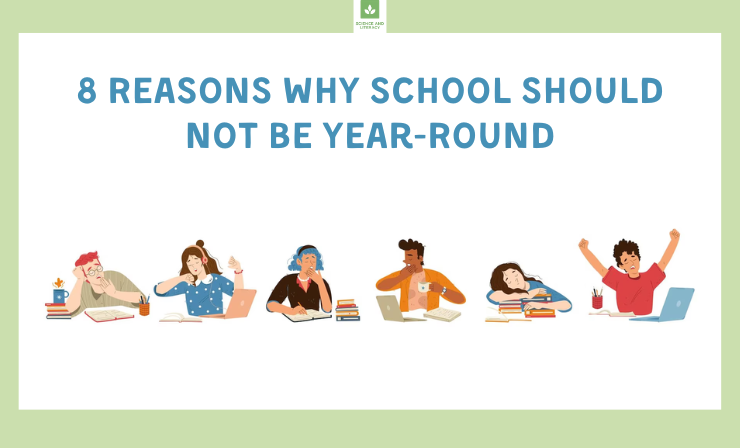
Year-round schooling, often perceived as a solution to the perennial issue of summer learning loss, reimagines the school year with shorter, more frequent breaks, as opposed to the conventional long summer vacation. This model is rooted in the belief that consistent engagement in educational activities can lead to better retention of knowledge and overall academic performance. However, this system is not without its critics, and a closer examination of its implications is crucial for a comprehensive understanding.
There should be an option (summer classes), but kids from broken homes should not be the reason why the state should school ALL kids all year round. It can kill creativity, & reduces bonding time w parents in favour of strangers. Some schools r great, in some areas they’re tragic — Blonde, you know what you are? (@BlondeAre) July 22, 2022
We will explore the drawbacks of year-round schooling, carefully balancing them against its benefits. These drawbacks range from potential impacts on family life and student mental health to logistical challenges faced by schools and districts. Furthermore, the article seeks to capture the voices of those at the heart of this issue – the students. Understanding their perspectives on year-round schooling is vital, as their experiences and opinions are central to the discussion.
By dissecting these various elements, this article aims to provide a thorough overview of the year-round schooling system. The goal is to equip parents, educators, and policymakers with a well-rounded understanding, enabling informed decisions that prioritize the needs and well-being of students in an ever-evolving educational landscape.
What you’ll find on this page:
- The Concept of Year-Round Schooling →
- How Does the Year-Round Schooling System Work? →
- What Kinds of Year-Round Schools Exist? →
- 8 Reasons Why School Should Not Be Year-Round →
- Benefits of Year-Round School →
- What Teens Think About Year-Round School →
The Concept of Year-Round Schooling
Many people assume that schools in the U.S. generally follow a nine-month academic year, but this is not always the case. While the majority do, a small portion, about 3,200 out of approximately 133,000 K–12 schools, operate on a year-round schedule. This doesn’t necessarily mean more school days; often, it’s the same number spread throughout the year instead of having a long summer break.
If you’ve ever wondered what it truly means to attend school throughout the entire year, this video offers an insightful exploration of this distinctive educational approach.
Year-round schooling involves distributing the teaching days evenly over the entire year. This approach can vary; some schools extend their academic year, while others spread the standard number of days over a longer period. The term “year-round” doesn’t imply continuous schooling all year or more school days than traditional schedules. It simply reorganizes the calendar to shorten the summer vacation.
The push for year-round schooling gained momentum due to concerns about students lagging in their studies, especially after the challenges posed by remote learning during the pandemic. Adrian Bustillos from the Aldine Independent School District in Texas highlighted the significant summer learning loss observed in recent years. Research indicated that students were falling behind by two to three years in subjects like math and reading.
To combat this, Harris Elementary School in the Aldine District switched to a modified calendar. Since 2018, the adoption of year-round schooling has grown from 2.5% to 4% in 2020, impacting over 3 million students across the country. Aldine ISD, spurred by state incentives, has extended the school year by 30 days at four of its schools, joining this emerging trend.
How Does the Year-Round Schooling System Work?
The year-round schooling system restructures the traditional academic calendar by breaking up the year into several shorter breaks instead of one extended summer vacation. Typically, these breaks might last two to three weeks, creating a more balanced schedule that allows for various unique activities. The structure of these breaks can vary: some schools might have four academic quarters of 45 days each, separated by 15-day breaks, while others could have three 60-day terms with 20-day intermissions, or even two 90-day halves with 30-day pauses in between.
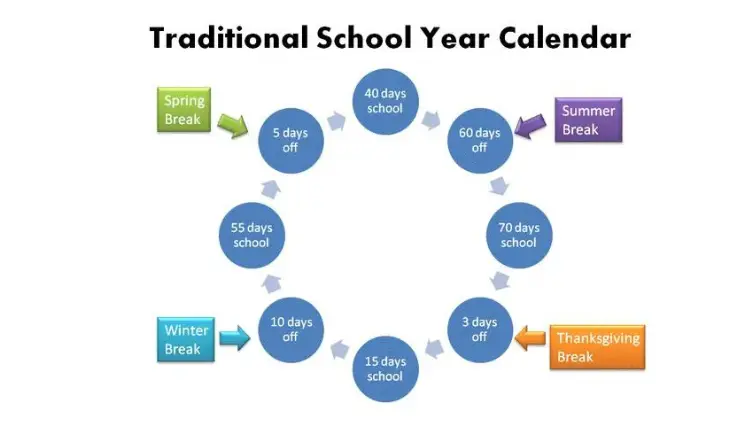
This system not only changes the rhythm of the school year but also offers students more flexibility in managing their assignments, as they have regular intervals to complete their work. If students struggle with their coursework, online assignment help is a viable option to consider.
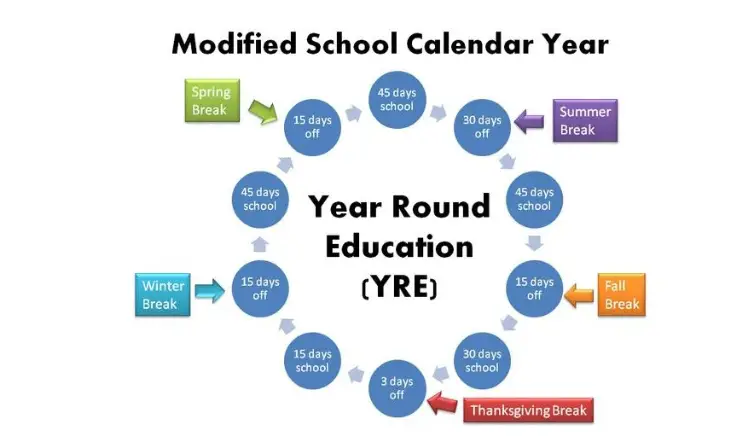
Additionally, some year-round schools include an “intersession,” an extra week or two for students to take additional courses outside their normal curriculum. This, however, extends the overall length of the school year. On average, year-round schools are open for about 189 days annually, which is nine days longer than the standard 180-day calendar.
In terms of organization, there are single-track schools where all students follow the same yearly schedule. In contrast, multitracking is used in some schools, especially to reduce overcrowding. In multitracking, different groups of students follow distinct academic calendars within the same institution.
What Kinds of Year-Round Schools Exist?
Year-round schools typically come in two formats: single-track and multi-track calendars. Both types rearrange the standard 180 school days to include several shorter breaks throughout the year, rather than a long summer vacation.
1. Single-Track Calendar
In the single-track, or balanced calendar, all students adhere to the same schedule. This approach often incorporates intersessions, which are periods for extra learning, offering an alternative to the conventional summer school model. The single-track calendar’s primary goal is to distribute breaks evenly throughout the year, maintaining a consistent academic rhythm.
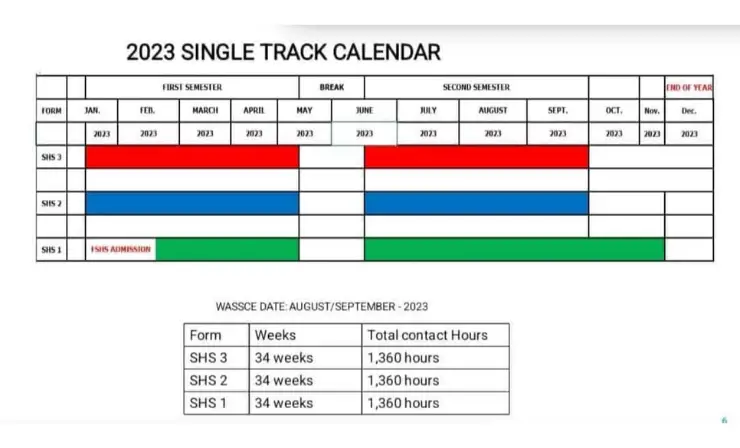
2. Multi-Track Calendar
The multi-track calendar, on the other hand, is usually adopted to address overcrowding in schools. It staggers schedules so that while some students are in school, others are on break. This system doesn’t necessarily extend the overall school year; instead, it shortens the summer break and introduces or extends breaks in other seasons.
Despite its name, the multi-track calendar doesn’t increase the total instructional days. Most of these calendars still operate for 36 weeks (180 days), similar to traditional schedules. An exception was the Concept 6 calendar, which only had 32 weeks of instruction.
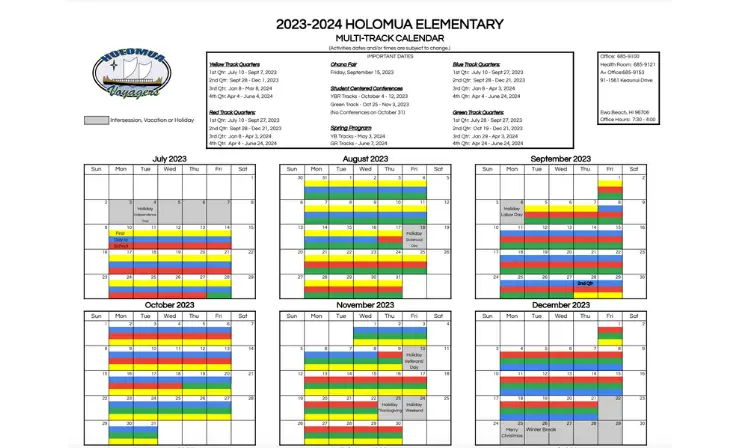
Traditional Schools vs. Year-Round Schools
To learn more and get ready for upcoming discussions, watch the video “Traditional Schools vs. Year-Round Schools.”
There was an initial belief that multi-track and other year-round calendars could enhance student achievement by reducing summer learning loss. The theory suggested that shorter, more frequent breaks would lead to better retention of knowledge. However, this hasn’t been consistently supported by evidence. Studies have shown that any educational gains made by attending school during the summer are offset by slower learning during breaks in other seasons.
Consequently, across all seasons, the amount of teaching and learning in multi-track systems is similar to that of traditional calendars. For example, from 1998 to 2011, California schools that switched to multi-track calendars did not show improved performance; in fact, they scored slightly lower than those on traditional schedules.
8 Reasons Why School Should Not Be Year-Round
While the benefits of year-round schooling are often highlighted, they may not be sufficient to outweigh its drawbacks. Firstly, the continuous academic calendar, though aiming to enhance learning, often disrupts the crucial balance between education and rest, potentially leading to student and teacher burnout. Additionally, the restructured schedule can significantly interfere with traditional family dynamics, complicating long-standing vacation plans and childcare arrangements.
Financial implications also emerge as a major concern, with both schools and families facing increased costs due to the extended operational demands of the year-round system. Furthermore, the alteration of the traditional summer break limits students’ opportunities for essential developmental experiences like summer jobs, internships, and leisure activities, which play a key role in holistic growth. With these significant issues in mind, let’s delve deeper into the reasons why year-round schooling might not be the optimal choice.
1. Difficulty in Retaining Information

Year-round schooling, characterized by its shorter breaks, may impede students’ ability to retain information effectively. Research has shown that students benefit from longer breaks, which provide ample time for the consolidation and processing of learned material. This is crucial for converting short-term memory into long-term understanding.
In a year-round schooling setup, the lack of extended breaks can lead to a repetitive cycle of learning new content and forgetting previously learned material due to insufficient processing time. Educational expert Dr. John Hattie’s research supports this, highlighting the importance of downtime in the learning process for deeper comprehension and retention. This constant cycle of superficial learning can ultimately hinder academic performance, as students might not develop a strong foundation in their knowledge base.
I recommend watching this insightful video featuring Professor John Hattie, currently serving as Professor of Education and Director of the Melbourne Education Research Institute at the University of Melbourne, Australia, since March 2011, and formerly a Professor of Education at the University of Auckland. His extensive research covers areas such as educational performance indicators, evaluation, creativity measurement, and various teaching and learning models, making this video a valuable resource for anyone interested in educational research.
Why It’s Important: The capacity to retain and process information effectively is a cornerstone of academic success. A schooling structure that potentially undermines this critical aspect of learning deserves thorough examination and consideration. The implications of compromised information retention are far-reaching, potentially affecting students’ academic trajectories and their preparedness for higher education and professional endeavors.
2. Risk of Student Burnout and Impact on Mental Health

Year-round schooling’s continuous academic schedule can significantly contribute to student burnout, negatively impacting mental health. Studies indicate that students in year-round settings experience higher stress and anxiety levels. The lack of substantial breaks for relaxation in such a system can lead to mental exhaustion, diminishing students’ capacity to manage stress and anxiety effectively.
Without adequate downtime, students are deprived of the opportunity to mentally recover from academic pressures, potentially leading to burnout. Psychologist Dr. Michael Thompson has noted the importance of breaks for psychological well-being in school-aged children. This unrelenting academic pressure can intensify mental health issues like anxiety and depression, adversely affecting students’ overall well-being and academic performance.
I highly recommend watching this insightful video featuring Michael Thompson discussing the significant pressure that schools place on children and the impact this has on their well-being and development.
Why It’s Important: The mental health of students is as critical as their academic achievements. The risk of burnout and the negative impact on mental health present significant challenges in the year-round schooling model. Prioritizing students’ mental wellness is essential, not only for their academic success but also for their long-term health and development. Ignoring these aspects could result in detrimental outcomes that extend beyond the classroom and into students’ future lives.
3. Increased Costs for Schools and Families

The transition to year-round schooling often entails additional expenses for both educational institutions and families. According to the National Education Association , schools could face up to 20% more in operational costs. This increase is due to the need for more staffing, modifications in scheduling, and higher demands for resources such as transportation and ongoing maintenance. For instance, a case study in California revealed that year-round schools required additional administrative staff and utility expenses to accommodate the year-long operation.
Families are also affected financially. With shorter and more frequent breaks, parents may need to arrange for more childcare, leading to increased expenses. Additionally, travel costs may rise as families try to plan vacations during off-peak times, which are often shorter and more crowded. A survey conducted by a parent-teacher association found that many families struggle with these additional childcare costs, making year-round schooling a less attractive option.
Watch CBS New York’s John Dias as he provides an insightful analysis of the latest figures in this engaging video.
Why It’s Important: The economic implications of year-round schooling are a critical factor to consider. These increased costs could make this educational model less viable for schools with limited budgets and for families who already face financial constraints. This situation could exacerbate educational disparities, hindering efforts to achieve greater equality in schooling access and quality.
Explore the compelling article “ Why Students Should Not Wear Uniforms: A Thoughtful Exploration with 9 Reasons, Studies, and Statistics ” to gain an in-depth perspective on the school uniform debate. Offering a detailed analysis supported by research and statistics, this piece thoroughly examines the reasons and consequences of adopting a no-uniform policy in educational institutions.
4. Disruption to Family Time and Challenges in Childcare and Family Scheduling

Year-round schooling significantly disrupts established family routines and complicates childcare and family scheduling. The frequent, shorter breaks that define this schooling model contrast sharply with the traditional long summer vacation, making it challenging for families to plan extended holidays and coordinate schedules. A study from a family counseling center highlights how these disrupted routines can impact family dynamics and children’s sense of stability.
Working parents, in particular, face added pressures in arranging consistent childcare during these intermittent breaks. This not only impacts the parents’ work-life balance but also adds to the family’s overall stress. For example, a survey of working parents showed that many had to make complex arrangements for childcare during shorter breaks, often at a higher cost and inconvenience.
I recommend watching “The Importance of Family Time: Luca at TEDxYouth,” a thought-provoking video that delves into the significance of spending time with family and its impact, as presented by Luca in a TEDxYouth talk.
Why It’s Important: The challenges posed by year-round schooling to family time and childcare are not just logistical but also emotional. Quality family time and stable childcare arrangements are essential for the healthy emotional and social development of children. Disruptions in these areas due to year-round schooling schedules can have significant ramifications on family well-being and children’s overall growth, making it a substantial drawback of this educational system.
5. Limitations on Summer Jobs and Internships

The structure of year-round schooling can significantly curtail students’ access to summer jobs and internships, which are traditionally aligned with the long summer break. According to the National Center for Education Statistics, the participation rate in these activities is notably lower for students in year-round schools. This discrepancy is primarily because the shortened breaks provided in year-round schooling overlap with the typical summer job and internship season. A survey conducted by a youth employment agency revealed that students in year-round schools often miss out on job opportunities that are not only a source of income but also crucial for gaining real-world experience.
This limitation can have far-reaching effects on students’ work experience, financial independence, and practical learning opportunities outside the academic environment. For example, internships in certain industries are predominantly available during the summer, and students in year-round schools may find themselves unable to take advantage of these opportunities.
Don’t miss this informative video which offers valuable insights into how summer internships can significantly benefit high school students’ learning and career development.
Why It’s Important: Summer jobs and internships play a critical role in preparing students for their future careers and in developing key life skills. They offer practical experiences that are invaluable in the job market and for personal growth. Therefore, the restriction imposed by year-round schooling on these opportunities is a significant concern, as it could adversely affect students’ readiness for the workforce and limit their skill development.
6. Teacher Burnout and Administrative Challenges

Year-round schooling can significantly increase the risk of teacher burnout and pose substantial administrative challenges. Research by the National Education Association has highlighted a higher incidence of burnout and job dissatisfaction among teachers working in year-round educational settings. The constant operation of schools throughout the year leaves teachers with limited opportunities to rest, recover, and engage in professional development, essential for their rejuvenation and effective teaching. Anecdotal evidence from teachers in year-round schools points to the heightened stress and reduced job satisfaction due to the lack of substantial breaks.
Administratively, the year-round model demands the coordination of complex schedules and continuous maintenance of school facilities, which can be both labor-intensive and financially burdensome. School administrators often find themselves grappling with logistical complexities and resource allocation challenges unique to this system.
I highly recommend watching the video “The Burnout Equation: America’s Teacher Shortage Crisis” for an in-depth understanding of the current challenges faced by educators in the U.S. and the growing crisis of teacher shortages due to burnout.
Why It’s Important: Teacher well-being is paramount to the quality of education provided, and their burnout can negatively impact student learning and overall school morale. Furthermore, the efficiency of school administration is crucial for the smooth functioning of any educational model. The increased strain placed on teachers and administrators in year-round schooling systems represents a significant drawback, potentially compromising the effectiveness of education and the health of the educational environment.
7. Logistical Complications, Extracurricular Disruptions, and Complexity in Scheduling and Resource Allocation

The shift to year-round schooling brings with it a host of logistical challenges, particularly in managing varied schedules and integrating extracurricular activities within this framework. This complexity often results in operational difficulties for schools, as evidenced by a study from the School Administrators Association , which found that year-round schools frequently struggle to synchronize their academic calendar with extracurricular and interscholastic sports schedules. This misalignment can lead to students missing out on crucial activities that contribute to their overall development.
Furthermore, efficient resource management becomes a pressing issue as schools must continuously navigate staffing, facility usage, and budget allocations without the traditional downtime of summer. This ongoing operation often demands more dynamic resource management strategies, as highlighted in a report by the Educational Resources Planning Institute , which points to the increased burden on administrative staff to ensure seamless school functioning.
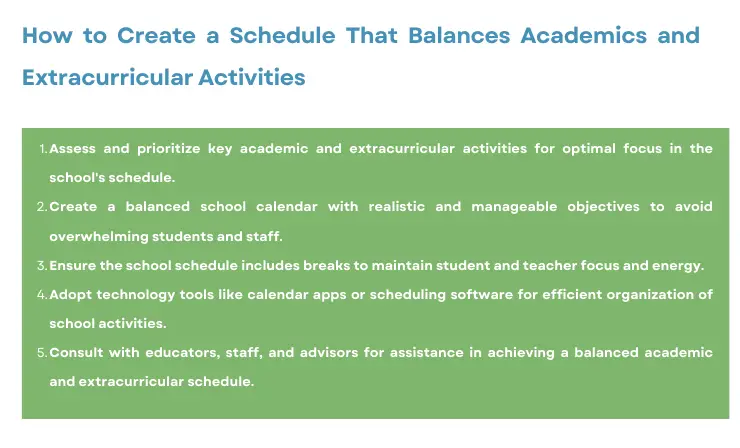
Why It’s Important: The ability of schools to operate smoothly and offer a diverse range of extracurricular activities is fundamental to providing a comprehensive educational experience. The additional logistical and scheduling complexities that come with year-round schooling can significantly impede these aspects, potentially detracting from the quality of education and the enrichment of students’ school life. These operational challenges represent considerable drawbacks, underscoring the need for careful planning and resource allocation in year-round educational settings.
8. Restrictions on Traditional Summer Activities

Year-round schooling substantially restricts students’ participation in traditional summer activities, a key component of their social and personal development. The condensed summer breaks inherent in year-round calendars mean students are in school during periods typically reserved for summer camps, sports, and other enriching activities. A survey conducted by the American Camp Association revealed a decrease in enrollment from students attending year-round schools, suggesting a direct impact on their ability to participate in such programs.
These limitations not only restrict students from engaging in recreational and developmental pursuits but also curtail their opportunities for social interaction and exploration of interests outside the academic sphere. This restriction is particularly evident during what is traditionally a more relaxed and explorative period for students. The impact is seen in a study by the Youth Development Institute , which shows that students in year-round schooling miss crucial opportunities for unstructured play and exploration, which are essential for holistic growth.
I recommend watching this informative video showcasing the diverse range of day and summer camps offered by the YMCA of Greater Cleveland, perfect for exploring various fun and engaging activities for children.
Why It’s Important: Engagement in summer activities is crucial for the all-round development of students. These activities provide diverse learning experiences, aiding in the development of social skills and personal interests, which are not typically addressed within the confines of a classroom. The reduction of these opportunities in year-round schooling can have significant implications on the overall growth, well-being, and future prospects of students, highlighting a major drawback of this educational model.
Overall, while year-round schooling offers certain advantages like reduced learning loss and continuous academic engagement, it also presents several significant drawbacks. These include challenges in retaining information, increased risk of student and teacher burnout, financial burdens, disruptions to family life and extracurricular activities, limitations on traditional summer experiences, and complexities in school management.
These factors collectively suggest that the potential negatives of year-round schooling may outweigh its benefits, making it essential for educators, parents, and policymakers to carefully weigh these considerations when deciding on the best educational model for their communities.
Benefits of Year-Round School
Although the concept of year-round schooling is met with various objections, it is not without its merits. Let’s delve into the potential benefits that this educational structure may offer.
Check out this intriguing video where Special Correspondent Alison Steward takes us inside a West Virginia school that has successfully adopted a year-round calendar. This insightful exploration reveals how spreading the same number of teaching days throughout the year, as done by this school, impacts student achievement. Administrators, teachers, and parents share their experiences, making it a must-watch for anyone interested in how altering the school calendar can influence educational outcomes.
1. Reduced Learning Loss vs. Disrupted Family Routines
Traditional summer vacations often lead to a regression in students’ academic skills, particularly in critical areas like math and reading. Year-round schooling, with its shorter, more frequent breaks, helps maintain academic continuity, reducing this ‘summer slide.’ This consistent educational engagement prevents the substantial knowledge loss typically observed after long periods of academic inactivity, helping students stay on track with their learning goals.
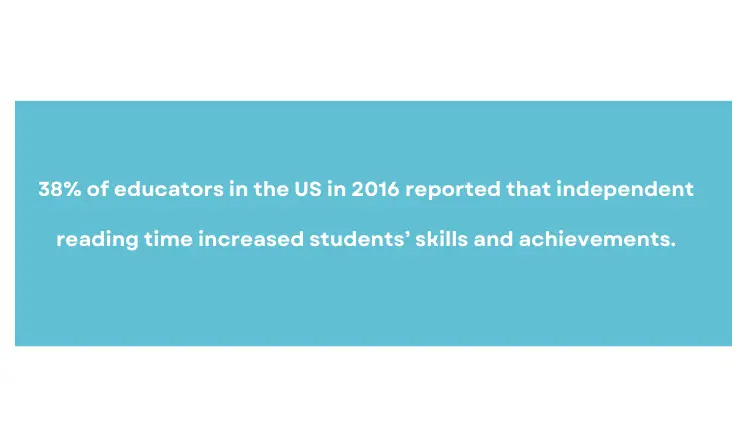
While year-round schooling can reduce learning loss by avoiding long summer breaks, it may disrupt traditional family routines. Families accustomed to long summer vacations for bonding and relaxation might find the frequent breaks throughout the year challenging to adapt to, potentially affecting family dynamics and time for extended family gatherings.
2. Consistent Engagement vs. Overburdening Students
Year-round schooling keeps students in a continual learning mode. This consistent engagement helps in maintaining a steady academic rhythm, preventing the disruption often caused by the long summer break. It ensures students remain in the habit of studying, attending classes, and engaging with educational material, which can lead to better academic performance and a more stable learning environment.
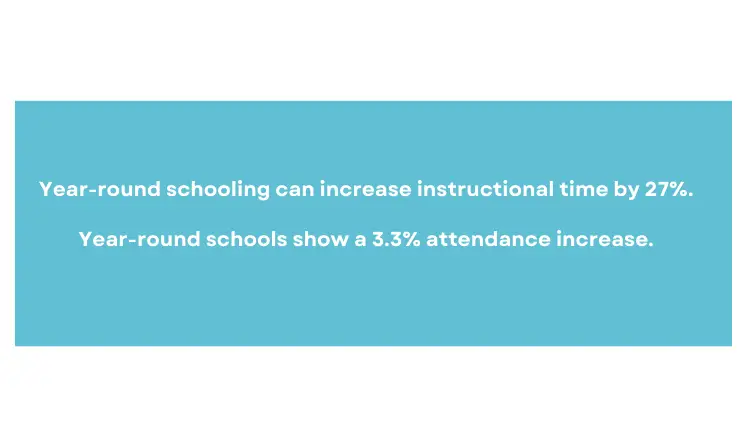
Although consistent engagement in year-round schooling prevents the disruption of long summer breaks, it could also lead to student fatigue. Continuous academic pressure without a substantial break might overburden students, potentially leading to burnout and a decrease in overall enthusiasm for learning.
Discover enlightening perspectives in “ 7 Research-Based Reasons Why Students Should Not Have Homework: Academic Insights, Opposing Perspectives & Alternatives “. This engaging article delves into the effects of homework on students, presenting well-researched arguments and examining various alternative approaches to foster effective learning.
3. Better Use of Resources vs. Increased Operational Costs
This system allows for a more efficient use of school facilities and resources. In multi-track systems, it can help manage overcrowding by having only a portion of the student body on campus at any given time. This not only maximizes the use of school facilities but also helps in maintaining smaller classes.
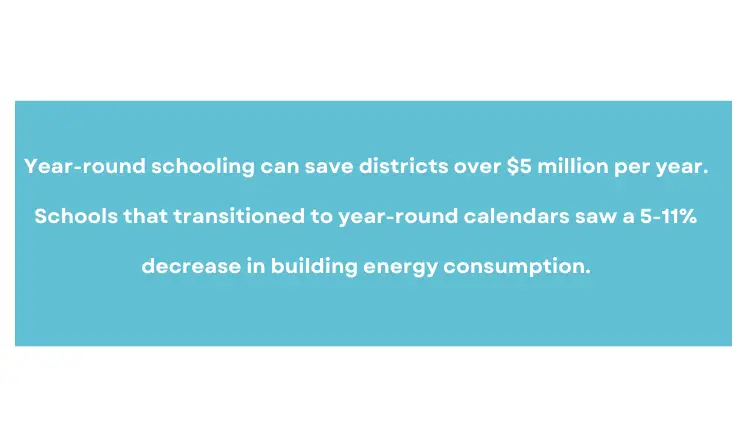
While year-round schooling allows for more efficient use of school facilities, it can also increase operational costs. Schools might face higher expenses related to utilities, maintenance, and staff salaries due to the continuous use of the facilities, which can strain school budgets and, by extension, taxpayer resources.
4. Enhanced Teacher and Student Well-being vs. Challenges in Extracurricular Planning
Regular breaks throughout the year can lessen stress and burnout among both teachers and students. This can foster a healthier school environment, as regular intervals for rest and rejuvenation can enhance overall well-being. Teachers may return more refreshed and prepared, which can positively impact their teaching effectiveness and student engagement.
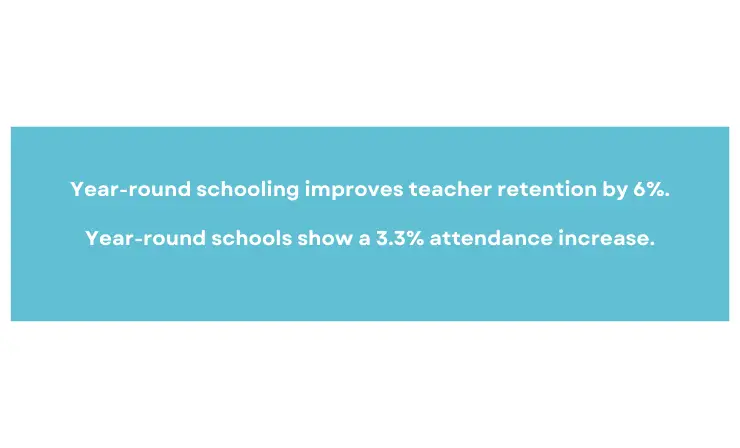
Regular breaks in year-round schooling can improve well-being, but they can also complicate extracurricular activities planning. Sports and other activities traditionally aligned with the longer summer break may struggle to find suitable schedules, potentially limiting students’ opportunities to engage in these important developmental experiences.
Dr. Matthew Lynch, an award-winning writer, activist, and editor of The Edvocate and The Tech Edvocate, discusses the year-round school system. He notes that while it can reduce summer learning loss and encourage innovative programs, it also disrupts family life, complicates childcare, affects extracurricular activities, increases administrative burdens, and requires effective use of extended school time to improve student performance. These challenges suggest that the drawbacks might outweigh the benefits.
- What Teens Think About Year-Round School
Most American teenagers are used to the traditional school year running from August to May, with a lengthy summer break for rejuvenation. However, those in year-round schooling might have a different perspective. The decision between these two models is complex for school administrations.

In Dianna Mendez’s research on year-round education (YRE), a key observation was made during a summer visit to relatives in California. Contrary to the traditional school schedule, it was noted that her cousins were still attending school, which was an intriguing deviation from the norm. Mendez’s research further delved into the specifics of this year-round schedule.
To gather diverse perspectives, Mendez conducted interviews with approximately 38 students from traditional schools regarding the concept of year-round schooling. The responses varied, with some students open to the idea, citing benefits such as preventing long breaks that lead to learning loss and allowing more time for morning routines or evening homework. Others expressed concerns about the long summer break being more conducive to diminishing learning retention and the difficulty of re-adjusting to school routines after such breaks.
“I believe that schools across America should not be open year-round. With schools open year-round, more pressure can be put upon a student. Summer vacation gives students time to relax and a stress-free break. Studies show school does increase the chances of depression and anxiety in teens. The year-round school would increase these chances. Year-round school could also hurt the economy. There would be no “back-to-school” sales, which means no extra income during this time of year. Many students also obtain summer jobs, teaching them responsibility. Summer vacation is necessary for our children to be happy and to become well-adjusted young adults.” — Megan
“I believe that kids should have the right to be kids. When you were a kid, didn’t you dream of summer? No school? Every kid longs for a long break when the work finally pays off. School in the summer helps kids—doing stuff they love or exploring new adventures, but it (YRE) also means that parents would be paying more money if their children go year-round.” — Grace
“I would rather finish one entire school year and have the entire three months than to be year-long in school and have breaks in between. I wouldn’t want to be in a year-long school because I wouldn’t want to feel like I’d be stuck in school forever. I think students would focus better knowing they only need to finish nine months of school, and then they can have a long break to look forward to.” — Gabriel
“I disagree. I think children need a break. I mean, if you put them in a year-round school, I wouldn’t be surprised if the suicide rate were much higher. I support the traditional school calendar because it has worked for centuries.” — Kevin
“I think going to school all year around is a very bad idea. If schools do that, students would be so depressed. They wouldn’t even be motivated to finish the year because there is no end of the year. Their brains would be fried, and everyone would be dead. Having breaks allows for family vacations and are easier for parents to get off work.” — Alyssa
“Imagine you are lying out in the sun. The sound of waves in your ears and beautiful sand all around you. A beach umbrella over your head. Sound peaceful? Too bad you can’t fully enjoy it because in the back of your mind, you are stressing about an English paper due in the morning. No, with year-round school—you will never truly have that break from school and the relief it brings.” — Giselle
Useful Resources
- Why Schools Are Important: The Benefits
- What are the major problems in schools?
- Summer Activities in School: A Guide to Fun and Learning Outdoors
Final Thoughts
In conclusion, while year-round schooling presents an innovative approach to education, it is evident that its complexities and challenges cannot be overlooked. The insights gathered from various aspects of this model, especially the perspectives of those directly affected – the students – highlight the need for a cautious approach. Before making any sweeping changes to our educational system, it is crucial to consider the full spectrum of implications, ensuring that the well-being and holistic development of students remain at the forefront of educational reform.
Explore “ 8 Reasons Why Students Should Have Mental Health Days: A Research-Based Analysis ” for a deep understanding of mental health’s role in education. This article provides an in-depth, data-driven examination of the necessity of mental health days for students’ well-being and academic achievement, advocating for their integration into educational policies.
- Why Year Round School Is A Bad Idea
- What Does Research Say About Staggered School Calendars?
- YEAR-ROUND SCHOOL: DIFFERENCE-MAKER OR WASTE OF TIME?
- Year-Round Schooling Grows in Popularity as States Incentivize Districts to Make the Switch
- Ask Dr. Lynch: What Are the Benefits and Drawbacks of Year Round Schools?
- Renowned child Psychologist Dr. Michael Thompson visits BIS
- YEAR-ROUND SCHOOLS: HOW IT AFFECTS TEACHERS
- Districts That School Year-Round
- AAA: Nearly 100 Million Americans Will Embark on Family Vacations this Year
- Recent Posts

Simona Johnes is the visionary being the creation of our project. Johnes spent much of her career in the classroom working with students. And, after many years in the classroom, Johnes became a principal.
- Exploring the Evidence: 7 Comprehensive Reasons Why School Should Start Later for Enhanced Student Well-being and Academic Success - February 15, 2024
- Why Students Should Learn a Second Language for Future Success: Exploring the 7 Benefits - February 12, 2024
- 9 Reasons Why Teachers Should Accept Late Work: Balancing Discipline and Flexibility in Education - January 31, 2024
Leave a Comment Cancel reply
Save my name, email, and website in this browser for the next time I comment.
The Edvocate
- Lynch Educational Consulting
- Dr. Lynch’s Personal Website
- Write For Us
- The Tech Edvocate Product Guide
- The Edvocate Podcast
- Terms and Conditions
- Privacy Policy
- Assistive Technology
- Best PreK-12 Schools in America
- Child Development
- Classroom Management
- Early Childhood
- EdTech & Innovation
- Education Leadership
- First Year Teachers
- Gifted and Talented Education
- Special Education
- Parental Involvement
- Policy & Reform
- Best Colleges and Universities
- Best College and University Programs
- HBCU’s
- Higher Education EdTech
- Higher Education
- International Education
- The Awards Process
- Finalists and Winners of The 2022 Tech Edvocate Awards
- Finalists and Winners of The 2021 Tech Edvocate Awards
- Finalists and Winners of The 2020 Tech Edvocate Awards
- Finalists and Winners of The 2019 Tech Edvocate Awards
- Finalists and Winners of The 2018 Tech Edvocate Awards
- Finalists and Winners of The 2017 Tech Edvocate Awards
- Award Seals
- GPA Calculator for College
- GPA Calculator for High School
- Cumulative GPA Calculator
- Grade Calculator
- Weighted Grade Calculator
- Final Grade Calculator
- The Tech Edvocate
- AI Powered Personal Tutor
How to Set Up and Start Using a Cash App Account
Jazz research questions, interesting essay topics to write about japanese culture, good research topics about japanese art, jane eyre essay topics, most interesting invisible man essay topics to write about, most interesting jaguar essay topics to write about, most interesting jackson pollock essay topics to write about, good essay topics on italian renaissance, good research topics about islamophobia, 3 reasons not to adopt year-round schooling.

I have long been a proponent of year-round schooling . In the past, I have often discussed why I feel that teachers should get behind the push to support year-round schooling and how more consistent time in the classroom will lead to higher student performance, boosting teacher accountability ratings and accommodating a much more streamlined education process. But is it really worth up-ending the school system as we know it?
Let’s look at some reasons to be concerned about changing from our traditional summers-off calendar to a year-round schooling model.
1. It could end up being more expensive.
The summer months are typically the highest ones for energy consumption. In fact, the average electricity bill for homeowners in the summer months goes up 4 to 8 percent. Having empty classrooms in the summer months means less money going out to air conditioning and prevents other warm-weather costs from hitting school utility budgets. It may seem like a minor point, but an increase in utility bills for one-quarter of the year really could hurt schools’ bottom lines.
2. The children won’t have enough down time.
Some childhood development experts believe that particularly when it comes to younger students, time off in the summer months is a vital component of healthy development. The argument follows that kids are not designed to spend so much of their time inside classroom walls and that the warmer, pleasant weather of the summer provides a perfect opportunity to get outside and experience childhood.
There’s a big problem with this argument, though. It’s that most children these days are not spending their summers frolicking in fields of flowers or running around their neighborhoods, hanging out with other kids.
The days of kids spending their summers outside, communing with nature and getting plenty of exercise, are long gone. A recent Harvard University study found that school-age children tend to gain weight at a faster pace during the summer months than during the school year, a fact attributed to more time spent in sedentary activities like watching television or using mobile devices instead of being outside or participating in active pursuits. Now, not only must K-12 students relearn the academic items, but they must also shift their mentalities from less-active, sedentary ones to sharp, alert learning models – and teachers face the brunt of this responsibility.
The American Academy of Child and Adolescent Psychiatry reports that by the time children graduate from high school, they will have spent more time watching television than in classrooms. What’s more – children who watch an excessive amount of television generally have lower grades in school, read fewer books and have more health problems. While some children visit summer camps, or attend child care when school is out, others stay at home, inside, with not much else to do than watch TV or play games on electronic devices. This is especially true for kids who are middle-school age or higher and are able to stay home alone when parents work. The “down time” of the summer months is really just empty time, often void of anything academically or developmentally advantageous.
3. There might be some scheduling issues caused by the calendar change.
For parents with children of different ages and in different schools, a year-round schedule could present serious scheduling issues. This argument assumes that schools would actually adhere to different time off schedules – something that seemingly could be adjusted so that all schools within a particular district or geographic area were on the same schedule. There is also the child care debate that says it would be difficult for working parents to find babysitters for one or two weeks at a time every few months, as opposed to three months straight in the summer. Again though, the market adjusts with demand and it seems to me that child care centers and camps would offer programs when students needed them. Just because those programs are not available now does not mean they would not exist when families were willing to pay for them.
The most common arguments against year-round schooling seem like a stretch. They reek more of the fear of change rather than actual concern. They are based on ungrounded assumptions and are simply not strong enough to stand against the reasons we should adopt a year-round schooling model here in the United States.
What arguments against year-round schooling do you hear? What ones do you agree with?
Learning Upgrade Launches New Mobile App to ...
How we finally left no child left ....
Matthew Lynch
Related articles more from author.

When Trump proposed a wall and California tore one down
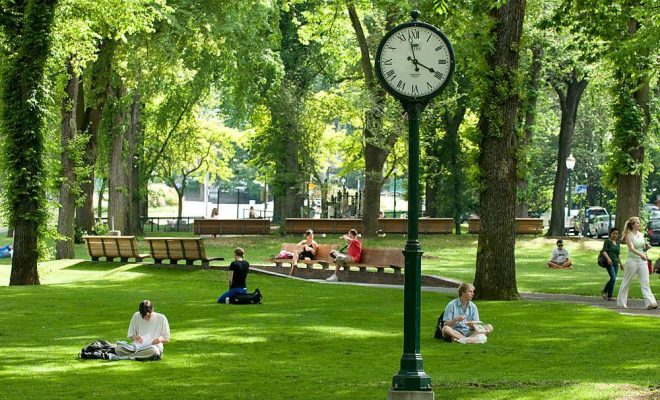
Why all Community Colleges Should Offer Bachelor’s Degrees
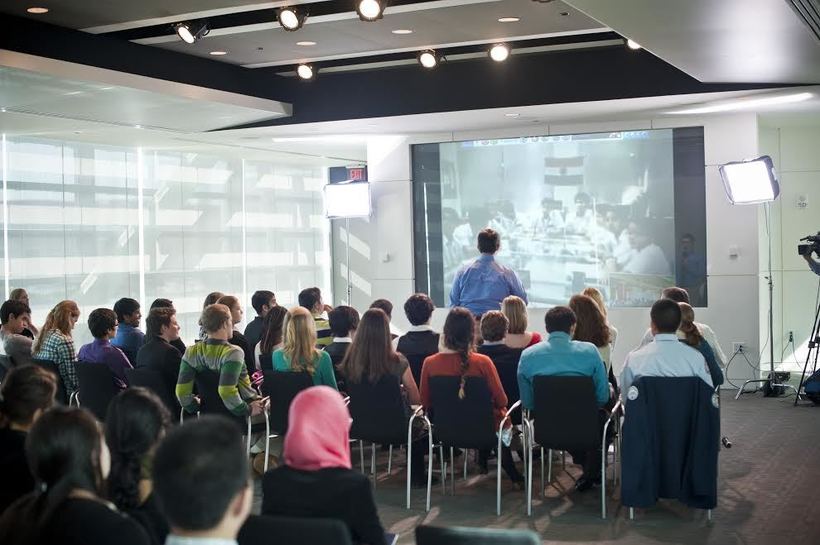
Promoting Student Achievement through Accountability and Assessment
Behavior matters: fostering a successful mindset, the rachael ray show surprises kindergarten teacher with redcat audio systems.

Designer Learning Experiences: Bridging the Gap for Low-Income and Minority Students
The Pros and Cons of Year-Round School Calendars
A balanced calendar replaces summer with shorter, more frequent breaks.
Pros and Cons of Year-Round School

Getty Images
Although students at a school with a balanced calendar might only get four or five weeks off in the summer, they’ll also get two weeks or so off in the fall, winter and spring.
For most children in the United States, the word “summer” evokes images of a carefree two- to three-month-long escape from the classroom.
But that summer break looks different for those on year-round school calendars, also known as balanced school calendars.
What Is Year-Round Schooling?
School districts using a year-round or balanced calendar redistribute the standard 180 days of classroom instruction more evenly over the course of a year.
Although students at a school with a balanced calendar might only get four or five weeks off in the summer, they’ll also get two weeks or so off in the fall, winter and spring. Some schools on this calendar also use a multi-track system, meaning that students are assigned to different groups, each with its own vacation schedule.
Though the vast majority of schools using a year-round calendar feature 180 days of instruction, some districts have tried extended year-round calendars, which add on extra school days in an effort to increase student achievement. Experts note, however, that these are fairly rare in the United States.
There are many different ways to divide up the balanced calendar, but a common model is the 45/15 version, wherein students attend school for a 45-day period, followed by a 15-day vacation. This cycle repeats four times throughout the school year, taking into account holidays that take place throughout the year (students on a balanced calendar still receive three days off around Thanksgiving, for example).
How Year-Round Schooling Got Started
Though longer, year-round school calendars were fairly common in the early days of American schooling, the traditional nine-month calendar prevailed as the norm by the beginning of the 20th century.
The year-round calendar as we know it today was introduced in the 1970s, as school districts looked for a way to deal with rapidly increasing student populations. By scheduling students on different tracks with staggered vacations, administrators could expand the capacity of existing school buildings. However, the number of public schools using this calendar declined from 6% in 1999 to just 3% in 2018, according to an analysis published in EducationNext . Many districts that do year-round schooling are in the South and West.
But since the COVID-19 pandemic, a few states and districts are looking at balanced calendars as a way to combat the learning loss that occurred following the shift to remote and hybrid learning in 2020. For example in Washington, the state superintendent's office used some of its emergency pandemic funding to introduce the Balanced Calendar Initiative, which has provided grants to more than 40 school districts to study the balanced calendar’s potential for their district.
And in South Carolina, about a quarter of the state’s school districts have switched over to the balanced calendar in the past three years, according to local news reports, with even more planning to make the change.
“The COVID-19 pandemic really gave school districts a reason to look at how we organize when teaching and learning happens,” says Latoya Dixon, assistant superintendent of academic innovation and professional learning at York School District 1 in South Carolina, which will be transitioning to a balanced calendar for the 2023-2024 school year.
Here are some of the pros and cons of year-round calendar systems.
Pros of Year-Round School
More frequent, evenly spaced breaks.
One of the advantages of a balanced calendar is that students get more frequent breaks throughout the year, which proponents of the model say can help reduce burnout among teachers and students.
Daniel Jones, a public high school teacher and doctoral student in educational leadership at St. Louis University , says he suspects that longer breaks during the school year could have a positive effect on students’ mental health, particularly in a post-pandemic world.
Dixon also notes that in her state, students on the traditional calendar have a slightly longer semester in the spring than they do in the fall.
“In terms of instruction, a student who takes Algebra I first semester receives 87 days of instruction, versus a student who takes Algebra I second semester gets 93 days,” she says, noting that the balanced calendar levels out this difference by creating more even periods of instruction.
Intercession Instruction
Year-round education allows for additional enrichment opportunities during the short breaks or "intercessions" that occur throughout the school year, allowing students to either catch up or get ahead in their studies.
Jones and Dixon agree that the year-round calendar can create some challenges for working parents who need to coordinate childcare during the added breaks throughout the year. To make up for that, many schools on balanced calendar systems offer additional instruction during those breaks.
“Some people have a misconception that year-round schools just let the kids go,” Jones says. “But they understand a lot of parents are working, so a lot of those schools will offer programming or enrichment opportunities during those intercessions.”
Less Summer Learning Loss
Advocates of year-round calendar systems often cite reduced summer learning loss as a reason to shift away from the traditional calendar.
The logic here seems sound – since students have shorter summer breaks, there’s less time to forget what they learned during the school year.
That said, a study by Paul von Hippel, associate dean for research at the University of Texas—Austin’s School of Public Affairs, found that while the year-round approach did increase summer learning, learning decreased during other times of the year, ultimately evening out the amount of learning loss between both calendars.
Cons of Year-Round School
Little evidence of academic benefits.
Von Hippel notes that much of the research cited in favor of the year-round calendar falls flat upon further scrutiny, as studies showing significant academic benefits tend to look at a fairly small sample size, and are often not even peer-reviewed.
He says studies that analyze data from several school districts show little in the way of significant educational improvements when schools switched to a year-round calendar – and some even see slight declines in academic performance.
“This is really what policymakers should be looking at,” von Hippel says.
Childcare Difficulties
Year-round education can pose a challenge for working parents who need to arrange childcare during breaks that don't align with their work schedules. When her district was voting on whether or not to adopt the balanced calendar system, Dixon says this was the most frequent complaint that skeptics of the calendar brought up.
Though childcare may be hard enough to figure out during the summer, it can be even more challenging to schedule ways to keep your child safe and occupied during those additional breaks, when most full-day camps and recreation programs are not available. This challenge might even discourage some parents from staying in the workforce altogether – von Hippel cites a 2013 study that found mothers in districts on the year-round calendar were less likely to enter the workforce when their children started kindergarten.
Shorter Summers
It’s no secret that the summer is a popular time for families to take time off. Shortening the season can make it harder for families to find the time for traditional summer vacations like hiking, camping or spending time at a nearby beach.
A briefer summer break also makes it harder for kids to attend a sleepaway camp or for teens to work a summer job or internship.
For families with multiple children, planning a vacation on the year-round calendar can be especially tricky. This is particularly difficult on a multi-track system, where one child might be on break while another child is in class, von Hippel says.
And given the fact that families often plan vacations well in advance, the transition from a traditional calendar to a balanced one can also be challenging. In addition to childcare troubles, Dixon says some parents in her district voted against the switch because they’d already scheduled their summer vacations and would have to go through the trouble of rescheduling to accommodate the new calendar.
See the 2022 Best Public High Schools

Tags: K-12 education , education , elementary school , students
2024 Best Colleges

Search for your perfect fit with the U.S. News rankings of colleges and universities.
Popular Stories
Best Colleges

College Admissions Playbook

You May Also Like
Ways students can spend spring break.
Anayat Durrani March 6, 2024

Attending an Online High School
Cole Claybourn Feb. 20, 2024

How to Perform Well on SAT, ACT Test Day
Cole Claybourn Feb. 13, 2024

High School Graduation Rates By State
Sarah Wood Dec. 1, 2023

Charter Schools vs. Public Schools
Jacob Fischler and Cole Claybourn Nov. 14, 2023

Understanding Media Literacy
Cole Claybourn Nov. 14, 2023

504 Plan Versus IEP: A Guide for Parents
Sally Kassab and Cole Claybourn Nov. 14, 2023

Nontraditional Student Admissions
Linda Lee Baird Oct. 31, 2023

Pros, Cons of Working in High School
Lilly Roser Sept. 29, 2023

What to Know About STEM High Schools
Sarah Wood Aug. 29, 2023

- Trying to Conceive
- Signs & Symptoms
- Pregnancy Tests
- Fertility Testing
- Fertility Treatment
- Weeks & Trimesters
- Staying Healthy
- Preparing for Baby
- Complications & Concerns
- Pregnancy Loss
- Breastfeeding
- School-Aged Kids
- Raising Kids
- Personal Stories
- Everyday Wellness
- Safety & First Aid
- Immunizations
- Food & Nutrition
- Active Play
- Pregnancy Products
- Nursery & Sleep Products
- Nursing & Feeding Products
- Clothing & Accessories
- Toys & Gifts
- Ovulation Calculator
- Pregnancy Due Date Calculator
- How to Talk About Postpartum Depression
- Editorial Process
- Meet Our Review Board
Pros and Cons of Year-Round School
Compassionate Eye Foundation / Robert Daly / OJO Images / Iconica / Getty Images
Year-round school calendars offer the same 160 to 180 days of schooling as the traditional nine-month school calendar. The difference is that the school vacations are distributed over the year rather than primarily in the summer. The long summer break is believed to have been created to ensure children were home to help parents harvest crops on family farms, a need that is no longer relevant for most families.
While the year-round schedule is not what most adults remember from their own school experience, it may not be as challenging or undesirable as some assume it to be. Children are not given less time off, but instead, the usual nine months on, three months off schedule is redistributed with a schedule of short instruction periods that alternate with shorter breaks across the whole year.
Learn more about the pros and cons of year-round school.
The Debate Over Year-Round School
Proponents of year-round schools say it may be a way to increase academic achievement and be beneficial to many working families, but opponents have also identified potential drawbacks. The debate over year-round schools has uncovered numerous pros and cons to be weighed by parents considering whether it is the right choice for their children and larger school community.
Pros of Year-Round School
Some of the pros of year-round schooling include:
- Decreased need to re-teach skills after long vacations, allowing teachers to use classroom time more efficiently.
- Extending the school year may help make teaching a full-time, more lucrative profession for educators if year-round schools can cut costs through multi-tracking programs.
- Families who struggle to find childcare or pay childcare expenses will benefit, as will children who are in sub-par childcare during summer vacation or after school care.
- Multi-tracking programs, those in which groups of students are on different school schedules, may allow for more school consolidation.
- Remediation needs can be addressed during the school year as opposed to during summer programs, possibly decreasing the need to include summer school in local budgets.
- Shorter summer breaks mean students are less likely to incur summer learning loss, which may increase academic performance for underprivileged children and decrease the number of students being served by intervention programs.
- Vacation time can be more evenly distributed throughout the year, making it easier to schedule family vacations and for students to revitalize themselves more frequently.
Cons of Year-Round School
Some of the arguments against year-round schooling include:
- Children in year-round schools would not be able to participate in sports teams or programs that operate in the summertime.
- Initial costs associated with starting or changing a traditional school to a year-round school are high.
- Multi-tracking programs mean that parents could possibly have children that are on different schedules.
- School budgets and staffing issues simply may not allow for extended school-year programs. Many schools already struggle to pay teachers a competitive wage, making it hard to keep high-quality teachers. The cost of teaching as a full-time endeavor may not be feasible either locally or federally.
- School maintenance costs, including day-to-day upkeep, air-conditioning, and utilities, can increase significantly t if schools are open during the summer.
- Students in year-round school may miss out on opportunities to spend time with children of other ages while learning about nature, as typical summer camp experiences may no longer be a part of the childhood experience.
- Teens who need to work to help support themselves or make money for college may have difficulty holding or finding a job if they do not have the entire summer off.
Increasing Popularity of Year-Round School
Frederick M. Hess, director of Education Policy Studies of the American Enterprise Institute for Public Policy Research , notes that few countries offer more than seven consecutive weeks of vacation for students. This contrasts with the United States' average of 13 weeks.
In a 2008 report titled "Summer Vacation Is No Longer Necessary," Hess suggested that following the agrarian calendar is an anachronistic way of running schools—that, although year-round school calendars are not a uniform solution, families should have more options for schools that operate year-round.
That opinion is gaining traction. In fact, a growing number of schools have opted to transition to a year-round calendar model.
According to an education policy report prepared for members of Congress in 2014, the number of year-round schools went from 410 (educating 350,000 students) in the 1980s to more than 3,700 (educating two million students) across 45 states in 2012.
Such growth in the numbers has school officials looking into research that examines both benefits in learning for students, but also how year-round schools affect the overall cost of education for all parties involved.
National Education Association. Research Spotlight on Year-Round Education.
Hess, Frederick M. Summer Vacation Is No Longer Necessary . Year-Round Schools . Ed. Adriane Ruggiero. Detroit: Greenhaven Press, 2008.
Skinner RR. Year-Round Schools: In Brief . Washington, DC: Congressional Research Service. 2014.

16 Pros and Cons of Year Round School
Instead of taking a full Summer vacation, a year-round school provides learning opportunities throughout the entire year. The school continues to operate on a 180-day learning schedule, which is mandatory in the United States. It simply takes shorter breaks between each term.
In the standard year-round format, students attend school for 45 days. Then they receive 15 days off. That’s the equivalent of attending school for 9 weeks, then taking three weeks off.
It is a change from the traditional idea of having a Summer break. There are questions about the value of having a continuous schedule instead of one with a longer break. Here are the pros and cons of year-round school to consider.

List of the Pros of Year-Round School
1. It can ease overcrowding issues in some school districts. One of the unique aspects of the year-round schedule is that it can provide three different tracks for students to follow. That means there are only two tracks attending school at any given time during the year. The year-round schedule, when employed on a 9/3 track, makes it possible to reduce school population sizes by 33% automatically. That allows the buildings to be in constant use while keeping classroom sizes low, which increases student learning opportunities.
2. It keeps the learning process ongoing. During the traditional Summer vacation, students can lose much of the information they learned from the previous grade. Year-round learning changes this dynamic. The students stay engaged with the learning process throughout the year, which reduces information loss. Even though the students at a year-round school attend the same days, they are at a slight advantage because the shorter breaks help them keep more of what they learned.
3. It eliminates the boredom of an extended break from school. Although the prospect of a long Summer vacation seems inviting, for many students, the reality of Summer is that it becomes very boring. Even families who have their students engaged in multiple activities can struggle to keep their children fully engaged during a break that can last as long as 12 weeks. By creating shorter breaks throughout the year, the opportunities for boredom decrease, which means there are fewer chances to get into trouble.
4. It reduces the need for remediation classes. Remediation is the process of re-learning what was already learned. Under the traditional school structure, the first 2-3 weeks of a new school year require remediation because of the extended Summer holiday. Under the format of a year-round schedule, the needs for student remediation can be addressed throughout the entire year, which makes the learning process more effective for students.
5. It reduces the need to have a Summer school. Many schools are already struggling with their budgets. Under the traditional schedule, a Summer school is often necessary to reduce remediation rates in high-risk students. Summer programs are implemented to keep students engaged with core educational elements. These all come at a cost. By keeping the school open year-round instead, the benefits of ongoing education are received without the added costs.
6. It gives families more options for vacation scheduling. Because there are extended breaks offered throughout the year, families in a year-round district have more opportunities to schedule a long vacation. They are no longer confined to the 12-week window of Summer or the 2 weeks offered at Christmas. Although this benefit may not apply to every family, it does offer options for some. Traveling during off-season days is also cheaper at most locations, which allows families to have the same amount of fun for less of a cost.
7. It is a proven format for schooling. Many countries around the world already employ the year-round schedule successfully. The traditional American Summer vacation is actually a global outlier. The data from other districts around the world show that there are numerous learning benefits which come from staying in school with shorter breaks throughout the year.
List of the Cons of Year-Round School
1. It can make it difficult for students to get involved with their work. When you’re in school for only 9 weeks at a time, you’re just getting geared up to begin the learning process when you’re released from school for an extended break again. For students who struggle to focus already, the frequent process of gearing up and winding down throughout the year can make it more difficult for them to stay involved with their work. It ends up creating more disruptions instead of preventing them.
2. It changes the family schedule. Instead of dealing with Summer supervision issues, working parents in a year-round school must deal with finding daycare for their children at periodic points throughout the year instead. It can be so difficult to juggle work and school with this type of schedule that two-parent households may have one parent stay at home to help manage it. Even if that is not necessary, the traditional summer vacation and other planned holidays require changes to fit with the calendar demands of the school.
3. It doesn’t provide year-round activities. Just because the school is going year-round doesn’t mean the district is providing activities for the students throughout the year. Most high schools do not provide competitive sports throughout the year. Teens want to be able to find a job, especially during the Summer months, to save up some cash or buy things they want. That process goes away if the school is wanting compliance with a year-round schedule.
4. It reduces building maintenance opportunities. Schools need to be maintained, just like every other building. When they are being used all year, every year, the opportunities to perform heavy maintenance activities, like resurfacing a floor, are reduced. That can increase the overall cost of maintenance for districts because they are forced to be proactive in how they maintain their facilities, which ultimately means taxpayers and home owners end up footing the extra expenses. Cost increases of 10% in this area are common.
5. It reduces opportunities for extra-curricular activities. Some teens need to work to support themselves, even in the United States. A year-round school schedule makes this difficult to accomplish. There are rules about how many hours a teen can work during a school day. For kids who are 14 or 15, they can only work 3 hours per day, or 18 hours per week, when school is in-session. If school is not in session, then they can work for 8 hours, up to 40 hours in a week. Many students must be home by 7pm as well with local youth employment laws on school days, providing further limitations.
6. It may cause some families to be on different schedules. When there are multiple tracks involved with a year-round school, some families may find their children on different schedules from each other. Under the 9/3 schedule, if a family had 3 kids, it is theoretically possible that one child would always be home during a break all year long. Schools do their best to prevent this from happening, but “doing their best” is not the same as a guarantee. That puts some families into a very difficult financial situation.
7. It prevents teachers from maintaining a secondary employment. Teachers often take a short-term, part-time job during the Summer as a way to supplement their income under the traditional format. That ability goes away during the year-round schedule. Although teacher wages have been rising in the United States in recent years, the national average starting teacher salary is still just $38,000, which is below the median income level. In Montana, starting teachers only make $30,000. Going to a year-round schedule may make it difficult for some teachers to be able to make ends meet.
8. It may create classroom environmental issues. In the United States, the schools that are being used in many districts are several decades old. The last survey of building age for public schools discovered that the average public school building is more than 40 years old. Many of these buildings are not equipped with air conditioning. Trying to hold classes in that environment, during the warm months of Summer, may be detrimental to the learning process.
9. It reduces the impact of traditional Summer programs. Many private companies and not-for-profit organizations rely on the extended break in the traditional American schooling schedule to fund their activities. Youth camps, for example, would need to change their entire way of providing services to accommodate the differences in the year-round schedule. Organizations like the Boy Scouts and Girl Scouts would need to restructure themselves in some ways as well. These impacts have financial costs which are not often calculated when looking at the advantages and disadvantages of year-round schooling.
The pros and cons of year-round school show that some families will thrive in that type of environment, while others do not. Students get the same amount of instructional time. Some will be focused. Others will not. That is why each key point must be individually evaluated to determine if this type of school schedule will be beneficial.
Subscriber Only Resources

Access this article and hundreds more like it with a subscription to The New York TImes Upfront magazine.
Article Options
Presentation View
Is Year-Round School a Good Idea?
iStockPhoto/Getty Images
The tradition of summer vacation grew out of a push in the late 19th century by education reformers to standardize school schedules. Before that, urban and rural schools often ran on completely different calendars. In the days before air-conditioning, many schools were sweltering in the summer, so time off then made sense. More than a century later, the tradition of a two-month summer vacation persists. In the past year, more schools have begun considering a switch to a year-round schedule as a way to counter Covid-related learning loss. This doesn’t mean more days in school; it just distributes them differently across the year. Two education experts square off about whether schools should change their calendars.
About 96 percent of all K-12 students in the U.S. attend schools that use the traditional school calendar, beginning each year around Labor Day and ending close to Memorial Day. But there is a better way: The “balanced school calendar” adjusts the 180-day school calendar to keep the learning process continuous throughout the calendar year.
In this form of year-round school, students have periodic, shorter breaks rather than one long summer intermission. The length of summer vacation is reduced from approximately 12 weeks to 6 weeks, and learning is designed around frequent breaks from school throughout the year.
One of the benefits of year-round school is that students have continuous access to learning, academic support, library books, and food. Without long breaks during which students forget material, there’s less need for reteaching topics that have already been covered. The balanced school calendar also allows for real-time remediation if a student falls behind: Students can use the scheduled breaks to complete unfinished assignments and get extra help.
Without long breaks, there’s less need for reteaching forgotten material.
Opponents often cite high school athletics, summer employment for staff and students, cost, and family traditions as barriers to changing the school calendar. But what we think of as the traditional school calendar was only adopted in the 1890s; before that, many schools operated essentially year-round.
Year-round school is actually more flexible and more in line with current lifestyles. Considering all the ways education has changed over the past 130 years, I continue to wonder why Americans have held on so tightly to the traditional school calendar. Perhaps it’s the love of long, lazy summer days or a fear of change. But those of us who’ve experienced the balanced school calendar—both educators and students—have come to love it.
—DAVID HORNAK
Executive Director National Association for Year-Round Education
Since the 1990s, thousands of schools nationwide have tried year-round calendars, hoping to raise student achievement. But research in many places—including school systems in California, Nevada, and North Carolina—has shown that such schedules didn’t raise kids’ test scores.
The reason is simple. Year-round calendars don’t increase the number of days that kids spend in school. Teachers don’t get any more teaching time, so students don’t learn any more.
Year-round calendars can also complicate family schedules. Imagine that your school uses a year-round calendar, but your brother’s or sister’s school uses a traditional calendar. Their school might be out when yours is in, and vice versa.
These scheduling complications can make it very hard for parents to cope. Research has shown that fewer mothers work outside the home when their kids’ schools switch to year-round calendars; instead, more mothers stay home so they can manage their children’s schedules. Some families even end up selling their homes and moving to areas where schools use traditional calendars. And this has been shown to cause a decrease in property values near schools that switch to a year-round calendar.
Year-round calendars don’t increase the number of days students are in class.
Some teachers can’t manage the year-round calendar either. Imagine that your school used a year-round calendar, but your teachers had kids in traditional schools. Your teachers would have to work and find child care when their kids’ schools were closed. For that reason, teachers often leave year-round schools for schools that use traditional calendars. This higher teacher turnover has a negative ripple effect on the quality of teaching because year-round schools end up with fewer experienced teachers.
The number of schools using year-round calendars has fallen by nearly half in the past 20 years. That’s because many schools have given up on a calendar that disrupts family life with no benefits for student achievement
—PAUL VON HIPPEL
Professor of Public Affairs, University of Texas, Austin
By the Numbers
PERCENTAGE of public schools that use a traditional school calendar.
NUMBER of students in the U.S. who attend a year-round school.
NUMBER of days in a typical school year, both traditional and year-round.
SOURCES: National Center For Education Statistics, National Association For Year-Round Education
Is It Time to Reconsider the Year-Round School Schedule?

- Share article
With schools rethinking how to educate students in 2020-21, some may turn to options they’d previously dismissed as too disruptive, too unpopular, or too onerous to plan for and execute.
The most prominent one? Year-round schooling, or a balanced calendar schedule, its lesser-known but more accurate name. In short, this option extends the academic calendar, shortens the summer break, and builds in regular intersessions for remediation, enrichment, and accelerated programs.
Year-round schools have been touted for reducing summer learning loss and improving teacher and student morale. But it’s proven unpopular too, for its disruption to family and communities’ routines, which are closely intertwined with the traditional school calendar. An estimated four percent of schools, serving about 3 million students, follow a year-round schedule, according to the National Association for Year-Round Education.
But the model provides some clear upsides for schools as the pandemic continues.

District and school leaders are confronting difficult, high-stakes decisions as they plan for how to reopen schools amid a global pandemic. Through eight installments, Education Week journalists explore the big challenges education leaders must address, including running a socially distanced school, rethinking how to get students to and from school, and making up for learning losses. We present a broad spectrum of options endorsed by public health officials, explain strategies that some districts will adopt, and provide estimated costs.
Part 1: The Socially Distanced School Day Part 2: Scheduling the COVID-19 School Year
It spreads attendance out across more months, and opens up more space on campuses to adhere to social distancing guidelines if districts opt to use more than one attendance track, where one group attends school for a particular period, while others are on break, and vice versa.
It allows schools to easily recoup learning days if they have to shut down because of a local outbreak. And it has built-in opportunities for remediation to address the learning losses that accrued during remote learning in the spring.
“I’m thinking we’re going to see more balanced calendar schools next fall and going forward as we continue to grapple with this particular virus,” said David G. Hornak, the superintendent of Holt Public Schools, in Holt, Mich., and the executive director of the National Association for Year-Round Education.
Here’s what a year-round schedule can look like:
Students receive at least 180 days of in-person instruction, as required by most states. Summer break is one month, not two. Other breaks are sprinkled across the year.
In one version, students attend school for six to nine weeks and then break for three weeks.
In the 6,000-student Holt school system, for example, schools on a balanced calendar start the first week of August and end in late June. (In contrast, schools on a traditional calendar in Michigan often open after Labor Day, and the school year continues through early June.)
The schools take a two-week break in October, during which students can participate in enrichment and remediation programs. There’s another weeklong break in February, and two weeks off in April. Because intersessions are used for enrichment or remediation, the district technically adds 25 more instructional days to the school year than Michigan’s required minimum of 180 days.
Adopting this model will still require adherence to public health practices during the pandemic, including social distancing, mask-wearing, hand-washing and sanitizing, and increased cleaning protocols in and around school buildings.
How to make it work:
Local context is everything. How school districts structure their year-round calendars hinges on what local communities decide works best. Enrollment size is a key factor, for example, in deciding whether all students can attend at the same time or whether multi-track attendance is better.
Local infection rates and other public health guidelines will also heavily influence districts’ decisions.
Buy-in from teachers is an essential first step and in districts with collective bargaining, the teachers’ union is a critical partner. Outlining the benefits of a year-round calendar, along with articulating clear goals for the switch to a new calendar are part of getting buy-in.
Once they’ve got teachers on board, leaders can approach parents and the community. Community support is crucial because the district must work with local child-care providers to ensure there are child-care options for parents during the more frequently scheduled breaks. And many local businesses often rely on high school students to work during the summer—a less pressing concern now, perhaps, in the pandemic; but those businesses also need to be included, Hornak said.
Districts must set up enrichment and remediation programs—either in person or remotely—for students during the intermissions. Teachers who agree to provide that instruction and support must be paid stipends for their work during those breaks, in addition to their salaries.
Because it’s a dramatic change, Hornak recommends that district leaders work with an expert who has experience with year-round schools. A proposal, he said, can be derailed if a community member asks a question and district leaders don’t have the answer.
Typically, more teachers aren’t necessary. But in the pandemic—with social distancing protocols in place—some new hiring and/or expansion of the substitute pool may be required. Staffing for transportation on a year-round basis may need to change. And how custodians and nurses are assigned to school may need to be adapted for following increased sanitizing and cleaning schedules and health protocols.
And because district leaders are pressed for time to get this rolling during the summer, they should immediately ask principals and supervisors to start working on plans they can execute on a quick turnaround.
- Schools provide a daily routine of face-to-face teaching, which puts them in a better position to respond to students’ educational, social, emotional, and mental-health needs.
- Year-round schools traditionally start earlier, so students can be back in classrooms sooner.
- The built-in intersessions will allow schools to readily plug in remediation and support programs to address learning loss.
- The shorter teaching cycles are less stressful for teachers and students. Teachers only have to plan for a few weeks at a time, and students get to take regular breaks and recharge.
- Multi-track year-round calendars can help districts efficiently use the space they have.
- Allows schools to shut down if an outbreak occurs without losing a lot of instructional time.
- Helps close opportunity gaps for lower income, special education, and other at-risk students who may not have access to the same resources and learning opportunities as their more-affluent peers during traditional summer breaks.
- Some risk of exposure or transmission of the virus.
- Subject to rapid shifts to remote learning if there’s a local outbreak of COVID-19.
- Need adequate supplies of masks, gloves, and hand sanitizer for staff and students, all new expenses.
- Increased cleaning and sanitizing schedules, which may require more custodial staff.
- New spending to pay for teachers’ stipends to work during intersessions.
- Transportation costs and complexity may rise to adhere to social distancing guidelines.
- Parent resistance to disrupted work and vacation routines and challenges with child care during intersessions.
- Reduced summer job opportunities for students and teachers.
- Requires special consideration and accommodations for teachers in high-risk categories, which may include work they can do from home or furloughing them until things return to normal.
- Requires formal agreement with the teachers’ union.

Sources, in alphabetical order: Brett Blechschmidt, chief financial officer, Vancouver Public Schools, Vancouver, Wash.; Sharon Contreras, superintendent, Guilford County Schools, Greensboro, N.C.; Daniel Domenech, executive director of AASA, the School Superintendents Association; Eric S. Gordon, CEO, Cleveland Metropolitan School District, Cleveland, Ohio; Todd Horenstein, assistant superintendent for administrative services, Vancouver Public Schools, Vancouver, Wash.; David G. Hornak, executive director, National Association for Year-Round Education (NAYRE) and superintendent, Holt Public Schools, Holt, Mich.; Mike Magee, CEO, Chiefs for Change; Scott Muri, superintendent, Ector County Independent School District, Odessa, Texas; L. Oliver Robinson, superintendent, Shenendehowa Central School District, Clifton Park, N.Y.; Mike Stromme, deputy superintendent of teaching and learning, Vancouver Public Schools, Vancouver, Wash.; Steven Webb, superintendent, Vancouver Public Schools, Vancouver, Wash.; Robert Zywicki, superintendent, Mount Olive Township School District, Mount Olive, N.J.
Documents: “Rising to the Challenge of Covid-19: A Planning Framework for the 2020-21 School Year,” (May 2020), Los Angeles County Office of Education; “Reentry to a New Normal,” (June 2020), Mount Olive Township School District; “Maryland Together: Maryland’s Recovery Plan for Education,” (May 2020) Maryland Department of Education; “Covid-19 Considerations for Reopening Schools: Initial Guidance for Schools and Districts (May 2020) Kentucky Department of Education; “Considerations for Reopening Mississippi Schools,” (June 2020) Mississippi Department of Education; “Scheduling Concepts for Hybrid Learning,” Aaron Dover, Los Angeles County Office of Education; “Considerations for Schools,” (May 2020) U.S. Centers For Disease Control and Prevention; “A Strong and Healthy Start: Safety and Health Guidance for Reopening Schools,” (June 2020) Vermont Education Agency and Vermont Department of Health; “A Guidebook for the Safe Reopening of California’s Public Schools,” (June 2020) California Department of Education
Sign Up for The Savvy Principal
Edweek top school jobs.

Sign Up & Sign In

Pros and Cons of Year-Round School

Is the traditional 10-month school year, starting around Labor Day and ending at the beginning of summer, still relevant? Year-round school, an alternative format, may offer valuable benefits. Examining the pros and cons of year-round school gives insight into why some education leaders push for its adoption while others argue for sticking to the traditional 10-month schedule.
Traditional vs. Year-Round Schedules
Many people think of the school year as starting in August or at the beginning of September and continuing for 10 months. Students get a summer vacation, as well as breaks in winter and spring.
This format has a long tradition. Some link it to our nation’s agrarian roots, saying it dates back to times when the US economy was based on farming and harvest cycles. Others observe that actual harvesting cycles don’t require long summer breaks. They suggest this extensive time off is more likely the legacy of wealthy urban dwellers leaving the city for long periods to escape the heat. Now, however, some districts are adopting a year-round schedule. What’s the difference? Year-round schedules still offer students 180 days of instruction, but those days are spread out over 12 months. After learning blocks, schools break for sessions that last weeks rather than months. Although the idea has been around for a long time, the change to year-round school has not been widely implemented. Today, 10 percent of students in the country attend schools that have adopted year-round schedules in 46 states and the District of Columbia.
Types of Year-Round Schedules
What exactly do year-round schedules look like? Some popular alternatives to the traditional schedule include the 45-15, 60-20, and 90-30 plans.
45-15 Schedules
On the 45-15 plan, students attend school for 45 days, followed by 15 days off. Schools still close for certain holidays that are built into the calendar. In all, students attend four 45-day sessions over 12 months.
Sample 45-15 Schedule
- 45 learning days (starting the fourth week of July)
- 20-day recess or intersession (starting the second week of October)
- 30 learning days (starting the third week of October)
- 3-day Thanksgiving recess
- 15 learning days (starting at the end of November or beginning of December)
- 15-day recess or intersession (over Christmas and New Year’s)
- 45 learning days (starting the third week of January)
- 15-day recess or intersession (starting the third week of March)
- 45 learning days (starting the second week of April)
- 30-day summer recess or intersession (starting the second week of June)
60-20 Schedules
On the 60-20 plan, students attend school for 60 days, followed by 20 days off. Schools close for holidays that are built into the calendar. Instead of four learning blocks, students learn during three 60-day blocks scheduled over the course of the year, separated by four weeks of vacation.
Sample 60-20 Schedule
- 60 learning days (starting the last week of September)
- 20-day recess or intersession (starting the fourth week of December)
- 60 learning days (starting the third week of January)
- 20-day recess or intersession (starting the second week of April)
- 60 learning days (starting the first week of May)
- 40-day summer recess or intersession (starting the last week of July)
90-30 Schedules
On the 90-20 plan, students attend school for 90 days, followed by 30 days off. Like the 45-15 and 60-20 plans, this schedule factors in holidays. The school year consists of two 90-day learning blocks, with a 30-day break after each.
Sample 90-30 Schedule
- 90 learning days (starting the fourth week of August)
- 30-day recess or intersession (starting the third week of January)
- 90 days of learning (starting the fourth week of April)
- 35-day summer recess or intersession (starting the second week of July)
What Are Intersessions?
After each learning block in the 45-15, 60-20, and 90-30 plans, schools may offer intersessions. Intersessions serve the same purpose as summer school, offering extra help and specialized programs for either full or partial days.
Intersession Remediation
For students struggling with classwork or failing a class, intersession remediation can help. During these sessions, teachers review and reteach the material covered earlier, giving students the chance to pass classes they are at risk of failing. Remediation can focus on everything from building basic literacy and math competencies to developing essential study skills.
Intersession Enrichment
Intersessions can also offer enrichment or accelerated courses, allowing excelling students the opportunity to push themselves to the next level. Depending on the grade level, enrichment could range from SAT prep to foreign language immersion to programs that have students plant a school garden while learning about conservation. Schools might also use these sessions for new student orientations or class trips.
Intersession Schedules
Intersession schedules vary according to school. However, they might feature morning classes, a lunch break, and then extracurricular activities in the afternoon. Intercessions may also offer half-day schedules that end midday.
Pros of Year-Round School
When considering such a high-level change, educators must look at both the pros and cons of year-round school. Supporters of year-round schedules argue that the schedule’s benefits justify its nontraditional nature.
Avoiding Summer Slide
Advocates of year-round education argue that students forget information they’ve learned in language arts and math over long summer breaks—the so-called summer slide. Shorter breaks can help students retain material learned while school is in session. Proponents also suggest at-risk students do better in year-round schedules. Some research suggests that by the ninth grade, summer learning losses account for two-thirds of the achievement gap between low- and middle-income students. However, much of the research is still inconclusive.
Saving Schools Money
Year-round schools use facilities more efficiently by accommodating more students thanks to staggered schedules, or track systems. Track systems divide students into groups who attend school on rotating schedules.
In a four-track system, only three tracks of students are on campus at a time. For example, a school with 1,000 seats could implement four tracks of about 333 students each. The school could rotate all four tracks in and out, thereby increasing enrollment capacity by about 25 percent.
Tracking can save districts the expense of constructing new schools and allows districts to make better use of the resources they already have. However, tracking can also create logistical hurdles. For example, with school buildings in constant use, administrators need to find alternative places to conduct intersessions—or forgo them altogether. Families with children who don’t follow the same schedule can encounter issues with scheduling child care or family vacations. Additionally, tracking may split up student cohorts, in this way disrupting social relationships and a sense of school community.
Offering Time for Intervention
Learning is cumulative, as curriculum bases later concepts on concepts learned earlier. Therefore, when students don’t master key concepts, they can lose ground quickly.
A traditional school year doesn’t give students much time to review concepts if they fall behind; however, year-round schedules with intersessions allow time for interventions that help struggling students catch up.
Cons of Year-Round School
Despite the benefits of year-round school, challenges are inevitable. Following are some of the key concerns surrounding making the switch.
Achieving Buy-In
Perhaps the biggest challenge of implementing year-round school is overcoming the doubts and concerns of participants, namely families and teachers. Understandably, supporters of year-round school may face challenges when it comes to buy-in.
Parents, for example, may demand more information about the benefits of year-round school to their children before they agree to a schedule change. Similarly, teachers may question how year-round schedules will affect their workload or compensation. School administrators may need to work closely with teachers’ unions and parent associations to make sure such concerns are addressed.
Juggling Logistics
Keeping a campus running at full capacity the entire year can be challenging. Districts need to address the issue of schools that lack air conditioning and may need to pay for higher energy consumption during the summer months.
Explore a Career as an Education Leader
Leaders in education continue to weigh the pros and cons of year-round school. As schools struggle to overcome achievement gaps and guarantee an equitable education to all students, educators continue to look for policies and approaches that can improve student learning.
Explore how the Online EdD in Education Policy and Leaderships from American University equips leaders with the skills needed to tackle the greatest challenges in education.
Effective Resource Management in Education: How School Administrators Can Improve Student Learning
Traditional vs. Progressive Education: Benefits and Challenges
What Is Systems Thinking in Education? Understanding Functions and Interactions in School Systems
Business Insider, “Year-Round School Is Booming—But Its Benefits Are Over-Hyped”
Education Next, “Is Summer Learning Loss Real?”
Education Week, “Is It Time to Reconsider the Year-Round School Schedule?”
Edutopia, “New Research Casts Doubt on the ‘Summer Slide’”
The Edvocate, “Year-Round Schools: 10 Things That You Should Know”
Encyclopedia.com, “Year-Round Education”
The Hour, “Editorial: Does Year-Round Schooling Add Up to Better Learning?”
National Education Association, “Research Spotlight on Year-Round Education”
PBS, “Agrarian Roots? Think Again. Debunking the Myth of Summer Vacation’s Origins”
Public School Review, “Year-Round or Traditional Schedule?”
Scholastic, “The Pros and Cons of Year-Round Schools”
Science News, “The Learning Gap Between Rich and Poor Students Hasn’t Changed in Decades”
Request Information
- Ethics & Leadership
- Fact-Checking
- Media Literacy
- The Craig Newmark Center
- Reporting & Editing
- Ethics & Trust
- Tech & Tools
- Business & Work
- Educators & Students
- Training Catalog
- Custom Teaching
- For ACES Members
- All Categories
- Broadcast & Visual Journalism
- Fact-Checking & Media Literacy
- In-newsroom
- Memphis, Tenn.
- Minneapolis, Minn.
- St. Petersburg, Fla.
- Washington, D.C.
- Poynter ACES Introductory Certificate in Editing
- Poynter ACES Intermediate Certificate in Editing
- Ethics & Trust Articles
- Get Ethics Advice
- Fact-Checking Articles
- International Fact-Checking Day
- Teen Fact-Checking Network
- International
- Media Literacy Training
- MediaWise Resources
- Ambassadors
- MediaWise in the News
Support responsible news and fact-based information today!
Arguments For and Against Longer School Years
This week, President Obama repeated his support for longer school years , pointing out that in many countries, kids attend school a full month longer than American kids. Of course, in some ways, it does not matter what the president thinks of this. School years are set on the state and local level. The federal government could provide some incentive funds for such an idea, but largely the issues of money and teacher union contracts affect the issue.
But, as you will see in some of the material to follow, there is far from conclusive proof that longer school years produce better students. No doubt, the studies say, some poorer performing students would benefit. But not all would. And a longer school day might produce even better results than a longer year would. Look at the information in the chart from this report by Edu in Review .
The 180-day calendar is shorter than that of other industrialized countries, and some schools even find ways to shave days even further . A story on the St. Louis Post-Dispatch’s website said:
“America’s traditional 180-day school year is more myth than reality in Illinois, as a jumble of state laws, rules and waivers allow districts to chip away instruction time, shorten school hours and cut the number of days students come to school.
“While Illinois requires 176 days of ‘actual pupil attendance’ already fewer than most states the vast majority of public school districts dip below that by one or two days and sometimes more, a Tribune analysis has found.
“Some 400,000 students in Chicago Public Schools attend school 170 days, with permission from state lawmakers. A similar waiver allows a suburban district to shave eight days off its calendar so teachers can work on improving student achievement when students aren’t there.
“What’s more, the Chicago Tribune found that in many districts, a day isn’t necessarily a day.
“Hundreds of districts send kids home early or have them come in late even as much as once a week to give teachers time to get training, meet with parents or collaborate. Districts can count these shortened days toward attendance requirements.”
Other voices on this topic
A fair number of studies question whether longer school years really would result in higher performance . The students who might benefit most are the students who have special needs or need remediation, two researchers found. Longer school years would cut down on how much students forget from the end of one school year to the start of the next.
Here is a briefing paper presented in 2009 [PDF] by the Center for Education Policy, Applied Research and Evaluation at the University of Southern Maine. The key research points included the idea that extending the school day could be more beneficial than extending the school year :
- “The issue isn’t time per se, but how it is spent
- “The key to increasing achievement is not necessarily more time in school but maximizing the amount of academic learning time
- “Any addition to allocated time will only improve achievement to the extent it is used for instructional time, which must then be used for engaged time, which, in turn, must be used effectively enough to create academic learning time
- “Quality is the key to making time matter … Educators must — to the greatest extent possible — make every hour count
- “Improving the quality of instructional time is at least as important as increasing the quantity of time in school
- “Most calculations suggest that a 10 percent increase in time would require a 6 to 7 percent increase in cost but could save parents money in child care costs”
Similarly, a researcher in Germany found that a shorter time in school did not affect average students’ learning of material in the core academic subjects [PDF]. But a report by the Massachusetts Teachers Association, the American Federation of Teachers, and Massachusetts 2020 had good things to say about longer school years .
USA Today reinforced the fact that views on this topic are mixed :
” … in Miami-Dade County, Fla., a three-year program in 39 underperforming public schools that included an extended school day and a longer school year produced mixed academic results, according to a final evaluation released last month. Administrators and teachers experienced fatigue and burnout, and many students did not attend class in the beginning of the summer, the report said.
” ‘Principals and teachers also reported that proficient students felt stigmatized by the mandatory additional time, which was viewed as a punishment rather than enhancement,’ program evaluators wrote.
“Other report findings showed students scored lower on the Florida Comprehensive Assessment Tests in reading or math compared with other students in the county. So it is not enough to ask how many days a kid is in school. You also have to ask what they are doing while they are in class. Half of the teachers who were part of a test group to get 300 more hours of teaching time in a school year said there was adequate time to cover the curriculum.”
So it is not enough to ask how many days a kid is in school; you also have to look at what they are doing while they are in class.

Opinion | Journalism schools must move beyond reporting to prepare graduates for modern media roles
As journalism rapidly evolves, J-schools must think critically about curriculums and equip graduates with skills for emerging roles across media.

Do Jesse Watters’ claims about the federal budget, LGBTQ+ and DEI funding add up?
The Fox News host’s five-part claim about programs funded by the latest federal budget ranges from missing context to inaccurate

Opinion | Wall Street Journal marks one year of reporter’s detainment in Russian jail
Evan Gershkovich was arrested a year ago today in Russia while on a reporting assignment for the Journal

A Baltimore bridge collapsed in the middle of the night and two metro newsrooms leapt into action
Coverage from The Baltimore Sun and The Baltimore Banner had much in common but with some marked differences — especially in visuals.

Private equity reporting grants show good return
Projects in Hawaii, Milwaukee and south central Indiana knit news organizations into community life
Start your day informed and inspired.
Get the Poynter newsletter that's right for you.
Pros and Cons of Year-Round School
- School Administration
- An Introduction to Teaching
- Tips & Strategies
- Policies & Discipline
- Community Involvement
- Technology in the Classroom
- Teaching Adult Learners
- Issues In Education
- Teaching Resources
- Becoming A Teacher
- Assessments & Tests
- Elementary Education
- Secondary Education
- Special Education
- Homeschooling
- M.Ed., Curriculum and Instruction, University of Florida
- B.A., History, University of Florida
Year-round school in the United States is neither a new concept nor an unusual one. Traditional school calendars and year-round schedules both provide students with about 180 days in the classroom. But instead of taking off much of the summertime, year-round school programs take a series of shorter breaks throughout the year. Advocates say the shorter breaks make it easier for students to retain knowledge and are less disruptive to the learning process. Detractors say the evidence to support this assertion is unconvincing.
Traditional School Calendars
Most public schools in America operate on the 10-month system, which gives students 180 days in the classroom. The school year typically begins a few weeks before or after Labor Day and concludes around Memorial Day, with time off during Christmas and New Year's and again around Easter. This school schedule has been the default since the earliest days of the nation when the U.S. was still an agrarian society, and children were needed to work in the fields during the summer.
Year-Round Schools
Educators began experimenting with a more balanced school calendar in the early 1900s, but the idea of a year-round model didn't really catch on until the 1970s. Some advocates said it would help students retain knowledge. Others said it could help schools reduce overcrowding by staggering start times throughout the year.
The most common application of year-round education uses the 45-15 plan. Students attend school for 45 days, or about nine weeks, then take off for three weeks, or 15 school days. The normal breaks for holidays and spring remain in place with this calendar. Other ways to organize the calendar include the 60-20 and 90-30 plans.
Single-track year-round education involves an entire school using the same calendar and getting the same holidays off. Multiple-track year-round education puts groups of students in school at different times with different vacations. Multitracking usually occurs when school districts want to save money.
Arguments in Favor
As of 2017, nearly 4,000 public schools in the U.S. follow a year-round schedule—around 10 percent of the nation's students. Some of the most common reasons in favor of year-round schooling are as follows:
- Students tend to forget a lot during the summer, and shorter vacations might increase retention rates.
- School buildings unused in the summer are wasted resources.
- Short breaks provide time for students to receive enrichment education.
- Remediation can occur when it is most needed during the school year.
- Students get bored during the long break of summer.
- It gives families more options for scheduling vacations, rather than restricting travel to summertime.
- Other countries around the world use this system.
- Schools on year-round schedules can accommodate more students through multitracking.
Arguments Against
Opponents say year-round schooling hasn't proven to be as effective as its advocates claim. Some parents also complain that such schedules make it more difficult to plan family vacations or child care. Some of the most common arguments against year-round schools include:
- Studies have not conclusively proven the academic benefits.
- Students forget information just as easily with a three-week break as 10. Therefore, teachers on a year-round system end up with four periods of review instead of just one at a new school year.
- Summer programs such as youth camps suffer.
- Student summer employment becomes virtually impossible.
- Many older school buildings do not have air conditioning, making a year-round schedule impractical.
- Band and other extracurricular programs can run into problems scheduling practices and competitions, which often take place during the summer months.
- With multitracking, parents could have students at the same school on different schedules.
School administrators considering year-round education should identify their goals and investigate whether a new calendar can help achieve them. When implementing any significant change, involving all stakeholders in the decision and the process improves the outcome. If students, teachers, and parents don't support a new schedule , a transition could be difficult.
National Education Association staff. " Research Spotlight on Year-Round Education ." NEA.org, 2017.
Niche.com staff. " Schools Without Summer Break: An In-Depth Look at Year-Round Schooling ." Niche.com, 12 April 2017.
Weller, Chris. " Year-Round School is Booming but Its Benefits Are Overhyped ." BusinessInsider.com, 5 June 2017.
Zubrzycki, Jacklyn. " Year-Round Schooling Explained ." Edweek.org, 18 December 2015 .
- The Pros and Cons of Block Schedules
- Pros and Cons of Teaching
- 10 Pros and Cons of Being a School Principal
- Examining the Pros and Cons of Standardized Testing
- How to Create a Homeschool Schedule
- Field Trips: Pros and Cons
- Parents Guide to the Pros and Cons of Homeschooling
- What are the Pros and Cons of Charter Schools?
- 11 Pros and Cons of Using Movies in Class
- The Pros and Cons of Allowing Cell Phones in School
- Advantages and Disadvantages of Lecturing
- The Pros and Cons of Getting a Journalism Degree in College
- Pros and Cons of Using a Traditional Grading Scale
- Whole Group Discussion Pros and Cons
- Negotiating Your Child's Resistance to Homeschool
- Should I Live On or Off Campus?
Home — Essay Samples — Education — High School — Discussion: Should School Be Year Round
Discussion: Should School Be Year Round
- Categories: Education System High School
About this sample

Words: 1218 |
Published: Dec 16, 2021
Words: 1218 | Pages: 3 | 7 min read
Works Cited
- American Academy of Pediatrics. (2014). School start times for adolescents. Pediatrics, 134(3), 642-649.
- Driessen, G., & Dekker, S. (2017). The impact of school holidays on student well-being and academic achievement. Journal of Youth and Adolescence, 46(4), 800-813.
- Elmore, T. C., & Rothman, R. (2020). The effect of year-round schooling on academic achievement: Evidence from mandatory school calendar conversions. Education Finance and Policy, 15(4), 646-668.
- Friedman-Krauss, A. H., Raver, C. C., Morris, P. A., & Jones, S. M. (2014). The role of classroom-level child behavior problems in predicting preschool teacher stress and classroom emotional climate. Early Education and Development, 25(6), 794-815.
- Heydenberk, W. (2015). The impact of year-round schooling on academic achievement: Evidence from a school lottery. Education Finance and Policy, 10(4), 520-546.
- Kraft, M. A., & Dougherty, S. M. (2013). The effect of teacher-family communication on student engagement: Evidence from a randomized field experiment. Journal of Research on Educational Effectiveness, 6(3), 199-222.
- Lleras-Muney, A. (2005). The relationship between education and adult mortality in the United States. The Review of Economic Studies, 72(1), 189-221.
- McKeever, P. M., & Miller, A. L. (2004). Mother-child conversations about gender: Understanding the acquisition of essentialist beliefs. Monographs of the Society for Research in Child Development , 69(1), 1-138.
- Owens, J. A., Belon, K., & Moss, P. (2010). Impact of delaying school start time on adolescent sleep, mood, and behavior. Archives of Pediatrics & Adolescent Medicine, 164(7), 608-614.
- Vandell, D. L., & Shumow, L. (1999). After-school child care programs. Future of Children, 9(2), 66-82.

Cite this Essay
Let us write you an essay from scratch
- 450+ experts on 30 subjects ready to help
- Custom essay delivered in as few as 3 hours
Get high-quality help

Verified writer
- Expert in: Education

+ 120 experts online
By clicking “Check Writers’ Offers”, you agree to our terms of service and privacy policy . We’ll occasionally send you promo and account related email
No need to pay just yet!
Related Essays
5 pages / 2090 words
3 pages / 1378 words
2 pages / 841 words
2 pages / 966 words
Remember! This is just a sample.
You can get your custom paper by one of our expert writers.
121 writers online
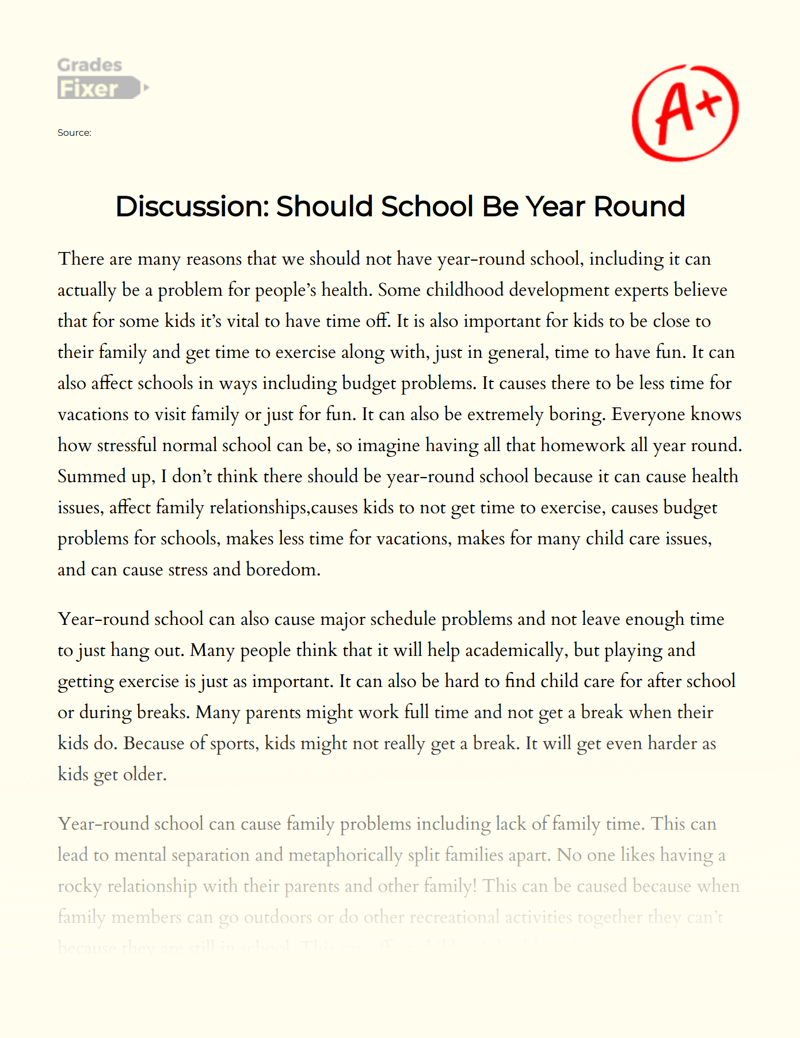
Still can’t find what you need?
Browse our vast selection of original essay samples, each expertly formatted and styled
Related Essays on High School
High school, the place where young minds are nurtured, friendships are forged, and the foundations of adulthood are laid. Or at least, that's what they want you to believe. In reality, high school is more like a three-ring [...]
Graduating from high school marks a significant milestone in one's life, and it is often accompanied by a sense of excitement and anticipation for the future. However, navigating life after high school can be challenging without [...]
High school is a critical phase in a student's academic journey, laying the foundation for future endeavors. Achieving success during this period requires a combination of effective strategies that can be applied to both [...]
Entering medical school is a significant step on the path to becoming a physician, and many students consider whether to take a gap year before embarking on this rigorous journey. A gap year, often a year-long break between [...]
Francine Prose wrote “I Know why the Caged Bird Cannot Read” to depict that American high school students learn to hate literature in part because they are asked to read mediocre, easy novels. She supports this claim by using [...]
The Breakfast Club is a 1985 American movie composed, created, and directed by John Hughes. It stars Emilio Estevez, Anthony Michael Hall, Judd Nelson, Molly Ringwald, and Ally Sheedy as youngsters from various high school [...]
Related Topics
By clicking “Send”, you agree to our Terms of service and Privacy statement . We will occasionally send you account related emails.
Where do you want us to send this sample?
By clicking “Continue”, you agree to our terms of service and privacy policy.
Be careful. This essay is not unique
This essay was donated by a student and is likely to have been used and submitted before
Download this Sample
Free samples may contain mistakes and not unique parts
Sorry, we could not paraphrase this essay. Our professional writers can rewrite it and get you a unique paper.
Please check your inbox.
We can write you a custom essay that will follow your exact instructions and meet the deadlines. Let's fix your grades together!
Get Your Personalized Essay in 3 Hours or Less!
We use cookies to personalyze your web-site experience. By continuing we’ll assume you board with our cookie policy .
- Instructions Followed To The Letter
- Deadlines Met At Every Stage
- Unique And Plagiarism Free
- Science & Math
- Sociology & Philosophy
- Law & Politics
Essay: Year Round School- A Mistake
- Essay: Year Round School- A…
Throughout time education has been considered a process that every so often must be improved. The education quality in the U.S. has declined over the years and people have been looking for a way to make improvements. A more recent proposal has been to go from a traditional nine-month schedule to an all-year program.
Supporters of year-round school claim it gives the student a better education. However, the prospect of a year-round school is not beneficial to the taxpayers’ pocket, to the education a student receives, or to the people involved with the district.
All year school ends up costing the school district and surrounding community more money than a traditional nine-month schedule. “More funds would be needed to cover the costs of paying the teachers and staff for one full year instead of for 180 days work.” ( Sevetson 2).
“Teachers currently make an average of $37, 000 in the United States. However, the costs would increase to $53, 000 to keep the teachers for a full year.” (Somerby 8). Currently, a district uses a lot of its budget on paying teachers. Once the increased costs are put in place, the budget depletes rapidly. Yet teachers must be paid, as they are the cornerstone of education.
Also, it takes additional funds to run the school all year, due to things such as air conditioning in the summer (White 28). Many schools do not currently need AC systems to be used. However, AC is a costly amenity and if schools are held open for three additional months, AC becomes a heavy factor. Not to mention, the level of supplies and paper that is consumed would be more than 33% larger (Sardo- Brown 26).
Costs per school for items, such as paper, increase due to constant use. (White 29). Students would be deprived of simple items such as worksheets or class handouts. Outside costs, such as transportation and equipment for activities would go up for constant maintenance (Sardo Brown 27). Buses that travel every school day use the district’s money for gasoline and repairs.
The money needed to cover the maintenance These costs can be very hard for a district to swallow because they must be covered by someone. Taxes would have to shoot up to solve the dilemma. Overall, the costs add up and equal a loss for students’ environment.
Due to the structuring, students and teachers would not be given time to recuperate from the prior year and to prepare for the future. Many students use the summer for a vacation with their parents. However, with a school in the summer, it would be much harder for a family to find a convenient time. Research shows that students would be more likely to burnout from school as they are not given an extended break in the summer (White 29).
Teachers are also not given enough time to prepare for their next incoming class (Sevetson 3). An unprepared teacher can only mean much more time wasted. The summer has also been a time when students can change their lifestyles. “Many students and teachers rely on the summer for a chance to mature and grow a little older. With year-round school, many lose that chance to change an attitude problem or become wiser.” (Sardo- Brown and Rooney 25). It is important that students continue to mature throughout high school.
The year-round school does not guarantee that this will occur. Time spent with friends would also decrease as many students run on different schedules. Friendship is one of the most important things in the development of today’s child (Sardo-Brown 27). However, year-round school separates most students into about two or three different schedules (Somerby 8).
Students are not given any preference as to which one they follow and it is simply a luck of the draw.
The biggest problem would be the adaptation to a schedule by the students and teachers. For students already in junior high or high school, the year-round school would be a hard schedule to follow (Sevetson 2). After years of following one method, they would be told to suddenly switch tracks completely. Students would then lose a chance for improved education.
Similarly, teachers would not have the time needed to take additional classes to improve their teaching methods (Somerby 9). ” How can a district expect education to improve if teachers can’t improve their own personal education ?” (Somerby 9). Students moving out of the district would be in conflict with a district that had a nine-month schedule.
“For a military family or any family that is at risk, a year-round schedule can only mean a nightmare.” (White 27). Also, special events such as graduation or the beginning of the school year would all be lost in the shuffle from year to year (Sardo- Brown 27). This means that after years of hard work in school, the graduating year would not matter.
A revision does indeed need to occur in the U.S. education system. The facts all do point to other countries flying by the U.S. However, year-round school is not what students need. It has too many downfalls and not enough benefits. Costs and scheduling are too huge of problems to be ignored. The nine-month schedule must remain the basis for education in America.
The changes that need to occur do not involve the schedule. They concern the actual education taught in classes. A change to the traditional calendar only sinks education lower off the charts.
Works Cited
Sardo- Brown, Deborah and Rooney, Micheal. “The Vote on All-Yaear Schools.”
American School Board Journal. July 1992; 25-27.
Sevetson, Martha. “Try, try Again: All Year Long.” The Wichita Eagle. 13 September 1992; 1D+
Somerby, Robert. “Are these the Right Goals for Education in the 90’s ?” The Baltimore Sun. 15 April, 1990. D8+ natl.ed.
White, William D. “Year Round No More.” American School Board Journal. July 1992; 27-30.
Related Posts
- Tips for Essay Writing
- High school Careers: Terms & Definitions
- Essay: We need more Practical Knowledge in our Education System
- Essay Analysis Structure
- Essay: What is an Education?
Author: William Anderson (Schoolworkhelper Editorial Team)
Tutor and Freelance Writer. Science Teacher and Lover of Essays. Article last reviewed: 2022 | St. Rosemary Institution © 2010-2024 | Creative Commons 4.0
Leave a Reply Cancel reply
Your email address will not be published. Required fields are marked *
Save my name, email, and website in this browser for the next time I comment.
Post comment
- Share full article
Advertisement
Why School Absences Have ‘Exploded’ Almost Everywhere
The pandemic changed families’ lives and the culture of education: “Our relationship with school became optional.”
By Sarah Mervosh and Francesca Paris
Sarah Mervosh reports on K-12 education, and Francesca Paris is a data reporter.
In Anchorage, affluent families set off on ski trips and other lengthy vacations, with the assumption that their children can keep up with schoolwork online.
In a working-class pocket of Michigan, school administrators have tried almost everything, including pajama day, to boost student attendance.
And across the country, students with heightened anxiety are opting to stay home rather than face the classroom.
In the four years since the pandemic closed schools, U.S. education has struggled to recover on a number of fronts, from learning loss , to enrollment , to student behavior .
But perhaps no issue has been as stubborn and pervasive as a sharp increase in student absenteeism, a problem that cuts across demographics and has continued long after schools reopened.
Nationally, an estimated 26 percent of public school students were considered chronically absent last school year, up from 15 percent before the pandemic, according to the most recent data, from 40 states and Washington, D.C., compiled by the conservative-leaning American Enterprise Institute . Chronic absence is typically defined as missing at least 10 percent of the school year, or about 18 days, for any reason.
Source: Upshot analysis of data from Nat Malkus, American Enterprise Institute. Districts are grouped into highest, middle and lowest third.
The increases have occurred in districts big and small, and across income and race. For districts in wealthier areas, chronic absenteeism rates have about doubled, to 19 percent in the 2022-23 school year from 10 percent before the pandemic, a New York Times analysis of the data found.
Poor communities, which started with elevated rates of student absenteeism, are facing an even bigger crisis: Around 32 percent of students in the poorest districts were chronically absent in the 2022-23 school year, up from 19 percent before the pandemic.
Even districts that reopened quickly during the pandemic, in fall 2020, have seen vast increases.
“The problem got worse for everybody in the same proportional way,” said Nat Malkus, a senior fellow at the American Enterprise Institute, who collected and studied the data.

Victoria, Texas reopened schools in August 2020, earlier than many other districts. Even so, student absenteeism in the district has doubled.
Kaylee Greenlee for The New York Times
The trends suggest that something fundamental has shifted in American childhood and the culture of school, in ways that may be long lasting. What was once a deeply ingrained habit — wake up, catch the bus, report to class — is now something far more tenuous.
“Our relationship with school became optional,” said Katie Rosanbalm, a psychologist and associate research professor with the Center for Child and Family Policy at Duke University.
The habit of daily attendance — and many families’ trust — was severed when schools shuttered in spring 2020. Even after schools reopened, things hardly snapped back to normal. Districts offered remote options, required Covid-19 quarantines and relaxed policies around attendance and grading .
Source: Nat Malkus, American Enterprise Institute . Includes districts with at least 1,500 students in 2019. Numbers are rounded. U.S. average is estimated.
Today, student absenteeism is a leading factor hindering the nation’s recovery from pandemic learning losses , educational experts say. Students can’t learn if they aren’t in school. And a rotating cast of absent classmates can negatively affect the achievement of even students who do show up, because teachers must slow down and adjust their approach to keep everyone on track.
“If we don’t address the absenteeism, then all is naught,” said Adam Clark, the superintendent of Mt. Diablo Unified, a socioeconomically and racially diverse district of 29,000 students in Northern California, where he said absenteeism has “exploded” to about 25 percent of students. That’s up from 12 percent before the pandemic.

U.S. students, overall, are not caught up from their pandemic losses. Absenteeism is one key reason.
Why Students Are Missing School
Schools everywhere are scrambling to improve attendance, but the new calculus among families is complex and multifaceted.
At South Anchorage High School in Anchorage, where students are largely white and middle-to-upper income, some families now go on ski trips during the school year, or take advantage of off-peak travel deals to vacation for two weeks in Hawaii, said Sara Miller, a counselor at the school.
For a smaller number of students at the school who qualify for free or reduced-price lunch, the reasons are different, and more intractable. They often have to stay home to care for younger siblings, Ms. Miller said. On days they miss the bus, their parents are busy working or do not have a car to take them to school.
And because teachers are still expected to post class work online, often nothing more than a skeleton version of an assignment, families incorrectly think students are keeping up, Ms. Miller said.

Sara Miller, a counselor at South Anchorage High School for 20 years, now sees more absences from students across the socioeconomic spectrum.
Ash Adams for The New York Times
Across the country, students are staying home when sick , not only with Covid-19, but also with more routine colds and viruses.
And more students are struggling with their mental health, one reason for increased absenteeism in Mason, Ohio, an affluent suburb of Cincinnati, said Tracey Carson, a district spokeswoman. Because many parents can work remotely, their children can also stay home.
For Ashley Cooper, 31, of San Marcos, Texas, the pandemic fractured her trust in an education system that she said left her daughter to learn online, with little support, and then expected her to perform on grade level upon her return. Her daughter, who fell behind in math, has struggled with anxiety ever since, she said.
“There have been days where she’s been absolutely in tears — ‘Can’t do it. Mom, I don’t want to go,’” said Ms. Cooper, who has worked with the nonprofit Communities in Schools to improve her children’s school attendance. But she added, “as a mom, I feel like it’s OK to have a mental health day, to say, ‘I hear you and I listen. You are important.’”
Experts say missing school is both a symptom of pandemic-related challenges, and also a cause. Students who are behind academically may not want to attend, but being absent sets them further back. Anxious students may avoid school, but hiding out can fuel their anxiety.
And schools have also seen a rise in discipline problems since the pandemic, an issue intertwined with absenteeism.
Dr. Rosanbalm, the Duke psychologist, said both absenteeism and behavioral outbursts are examples of the human stress response, now playing out en masse in schools: fight (verbal or physical aggression) or flight (absenteeism).

“If kids are not here, they are not forming relationships,” said Quintin Shepherd, the superintendent in Victoria, Texas.
Quintin Shepherd, the superintendent in Victoria, Texas, first put his focus on student behavior, which he described as a “fire in the kitchen” after schools reopened in August 2020.
The district, which serves a mostly low-income and Hispanic student body of around 13,000, found success with a one-on-one coaching program that teaches coping strategies to the most disruptive students. In some cases, students went from having 20 classroom outbursts per year to fewer than five, Dr. Shepherd said.
But chronic absenteeism is yet to be conquered. About 30 percent of students are chronically absent this year, roughly double the rate before the pandemic.
Dr. Shepherd, who originally hoped student absenteeism would improve naturally with time, has begun to think that it is, in fact, at the root of many issues.
“If kids are not here, they are not forming relationships,” he said. “If they are not forming relationships, we should expect there will be behavior and discipline issues. If they are not here, they will not be academically learning and they will struggle. If they struggle with their coursework, you can expect violent behaviors.”
Teacher absences have also increased since the pandemic, and student absences mean less certainty about which friends and classmates will be there. That can lead to more absenteeism, said Michael A. Gottfried, a professor at the University of Pennsylvania Graduate School of Education. His research has found that when 10 percent of a student’s classmates are absent on a given day, that student is more likely to be absent the following day.

Absent classmates can have a negative impact on the achievement and attendance of even the students who do show up.
Is This the New Normal?
In many ways, the challenge facing schools is one felt more broadly in American society: Have the cultural shifts from the pandemic become permanent?
In the work force, U.S. employees are still working from home at a rate that has remained largely unchanged since late 2022 . Companies have managed to “put the genie back in the bottle” to some extent by requiring a return to office a few days a week, said Nicholas Bloom, an economist at Stanford University who studies remote work. But hybrid office culture, he said, appears here to stay.
Some wonder whether it is time for schools to be more pragmatic.
Lakisha Young, the chief executive of the Oakland REACH, a parent advocacy group that works with low-income families in California, suggested a rigorous online option that students could use in emergencies, such as when a student misses the bus or has to care for a family member. “The goal should be, how do I ensure this kid is educated?” she said.

Relationships with adults at school and other classmates are crucial for attendance.
In the corporate world, companies have found some success appealing to a sense of social responsibility, where colleagues rely on each other to show up on the agreed-upon days.
A similar dynamic may be at play in schools, where experts say strong relationships are critical for attendance.
There is a sense of: “If I don’t show up, would people even miss the fact that I’m not there?” said Charlene M. Russell-Tucker, the commissioner of education in Connecticut.
In her state, a home visit program has yielded positive results , in part by working with families to address the specific reasons a student is missing school, but also by establishing a relationship with a caring adult. Other efforts — such as sending text messages or postcards to parents informing them of the number of accumulated absences — can also be effective.

Regina Murff has worked to re-establish the daily habit of school attendance for her sons, who are 6 and 12.
Sylvia Jarrus for The New York Times
In Ypsilanti, Mich., outside of Ann Arbor, a home visit helped Regina Murff, 44, feel less alone when she was struggling to get her children to school each morning.
After working at a nursing home during the pandemic, and later losing her sister to Covid-19, she said, there were days she found it difficult to get out of bed. Ms. Murff was also more willing to keep her children home when they were sick, for fear of accidentally spreading the virus.
But after a visit from her school district, and starting therapy herself, she has settled into a new routine. She helps her sons, 6 and 12, set out their outfits at night and she wakes up at 6 a.m. to ensure they get on the bus. If they are sick, she said, she knows to call the absence into school. “I’ve done a huge turnaround in my life,” she said.
But bringing about meaningful change for large numbers of students remains slow, difficult work .

Nationally, about 26 percent of students were considered chronically absent last school year, up from 15 percent before the pandemic.
The Ypsilanti school district has tried a bit of everything, said the superintendent, Alena Zachery-Ross. In addition to door knocks, officials are looking for ways to make school more appealing for the district’s 3,800 students, including more than 80 percent who qualify for free or reduced-price lunch. They held themed dress-up days — ’70s day, pajama day — and gave away warm clothes after noticing a dip in attendance during winter months.
“We wondered, is it because you don’t have a coat, you don’t have boots?” said Dr. Zachery-Ross.
Still, absenteeism overall remains higher than it was before the pandemic. “We haven’t seen an answer,” she said.
Data provided by Nat Malkus, with the American Enterprise Institute. The data was originally published on the Return to Learn tracker and used for the report “ Long COVID for Public Schools: Chronic Absenteeism Before and After the Pandemic .”
The analysis for each year includes all districts with available data for that year, weighted by district size. Data are sourced from states, where available, and the U.S. Department of Education and NCES Common Core of Data.
For the 2018-19 school year, data was available for all 50 states and the District of Columbia. For 2022-23, it was available for 40 states and D.C., due to delays in state reporting.
Closure length status is based on the most in-person learning option available. Poverty is measured using the Census Bureau’s Small Area Income and Poverty Estimates. School size and minority population estimates are from NCES CCD.
How absenteeism is measured can vary state by state, which means comparisons across state lines may not be reliable.
An earlier version of this article misnamed a research center at Duke University. It is the Center for Child and Family Policy, not the Center of Child and Family Policy.

IMAGES
COMMENTS
1. Difficulty in Retaining Information. Year-round schooling's shorter breaks may impede information retention, potentially leading to a cycle of learning and forgetting and superficial learning. Year-round schooling, characterized by its shorter breaks, may impede students' ability to retain information effectively.
Having empty classrooms in the summer months means less money going out to air conditioning and prevents other warm-weather costs from hitting school utility budgets. It may seem like a minor point, but an increase in utility bills for one-quarter of the year really could hurt schools' bottom lines. 2. The children won't have enough down time.
Year round schooling is becoming more and more common in USA. Although many schools still have the traditional summer break, many school are converting to year round schooling. From being unable to find appropriate child care, to a detriment to family structure, and a financial toll. First of all, schools should not convert to year round ...
School districts using a year-round or balanced calendar redistribute the standard 180 days of classroom instruction more evenly over the course of a year. Although students at a school with a ...
Pros of Year-Round School. Some of the pros of year-round schooling include: . Decreased need to re-teach skills after long vacations, allowing teachers to use classroom time more efficiently. Extending the school year may help make teaching a full-time, more lucrative profession for educators if year-round schools can cut costs through ...
List of the Pros of Year-Round School. 1. It can ease overcrowding issues in some school districts. One of the unique aspects of the year-round schedule is that it can provide three different tracks for students to follow. That means there are only two tracks attending school at any given time during the year.
The most common arguments against year-round schooling seem like a stretch, at best. They are based on assumptions that are not entirely grounded and reek more of the fear of change than of actual ...
The argument in favor of year-round school is that it prevents summer brain drain. There is less time for students to forget what they learned in the previous year, so teachers can spend less time reviewing material and more time applying existing knowledge to new concepts. "Research says students lose some of what they learned during the summer.
The length of summer vacation is reduced from approximately 12 weeks to 6 weeks, and learning is designed around frequent breaks from school throughout the year. One of the benefits of year-round school is that students have continuous access to learning, academic support, library books, and food. Without long breaks during which students ...
Here's what a year-round schedule can look like: Students receive at least 180 days of in-person instruction, as required by most states. Summer break is one month, not two. Other breaks are ...
Saving Schools Money. Year-round schools use facilities more efficiently by accommodating more students thanks to staggered schedules, or track systems. Track systems divide students into groups who attend school on rotating schedules. In a four-track system, only three tracks of students are on campus at a time.
Critics of year-round schooling cite the logistical problems it poses. Families with one child in year-round school and another in traditional school would find it difficult to plan vacations and events. School athletics would be more difficult to schedule if all schools are not on the same timetable. In addition, older students often look ...
Why the Cons of Year-Round School Outweigh the Pros. This persuasive essay argues against year-round schools. The student favors a school year oriented around a summer break, focusing on how the different schedules impact learning as well as student mental health. This essay received a C by one of Kibin's paper graders.
A story on the St. Louis Post-Dispatch's website said: "America's traditional 180-day school year is more myth than reality in Illinois, as a jumble of state laws, rules and waivers allow ...
Year-long school schedules typically have two-week-long seasonal breaks in the fall, winter and spring. For students, more frequent breaks lead to less stress. "Students and their teachers are less stressed because of the short breaks from school throughout the year, which may also lessen incidents of student conflict," says Joseph ...
Why We Should Not Convert To Year Round School Essay 991 Words | 4 Pages. When considering the choice of whether, schools should convert to year round schooling or not, the choice should definitely be schools should not convert to year round schooling. A few reasons schools should not convert to year round schooling is because students can even ...
Some advocates said it would help students retain knowledge. Others said it could help schools reduce overcrowding by staggering start times throughout the year. The most common application of year-round education uses the 45-15 plan. Students attend school for 45 days, or about nine weeks, then take off for three weeks, or 15 school days.
Year-round schools are becoming more and more popular around the world. Whether or not Florida should have year-round school has become a topic of increasing interest for several years. Florida should not have year-round school because year-round school disrupts students learning, and makes sports schedules and summer jobs difficult for students.
There are many reasons that we should not have year-round school, including it can actually be a problem for people's health. Some childhood development experts believe that for some kids it's vital to have time off. It is also important for kids to be close to their family and get time to exercise along with, just in general, time to have fun.
Year round schooling is a very good idea for many reasons such as how it would help give even more breaks and helps mentally, it gives kids more education, and it helps teachers with their lives too at school! Kids will still get breaks and year round schooling will be more beneficial to students education.…. 1690 Words.
More than 3,000 schools in the U.S. already follow a year-round schedule, and 47 out of our 50 states have at least one year-round school. These schools usually are in session for 45 days followed by a 15-day break. The breaks are long enough for students to recharge but not so long that they lose many of the gains of the previous academic period.
Persuasive Essay On Year Round School. 774 Words | 4 Pages. Year-Round Schooling A study from the 2011-2012 school year concluded that there were up to as many as 3,700 schools that operated on the year round schedule (Year-Round Schooling). Currently, a majority of schools run on the typical schedule where there is three months worth of summer ...
Essay: Year Round School- A…. Throughout time education has been considered a process that every so often must be improved. The education quality in the U.S. has declined over the years and people have been looking for a way to make improvements. A more recent proposal has been to go from a traditional nine-month schedule to an all-year program.
For the 2018-19 school year, data was available for all 50 states and the District of Columbia. For 2022-23, it was available for 40 states and D.C., due to delays in state reporting.